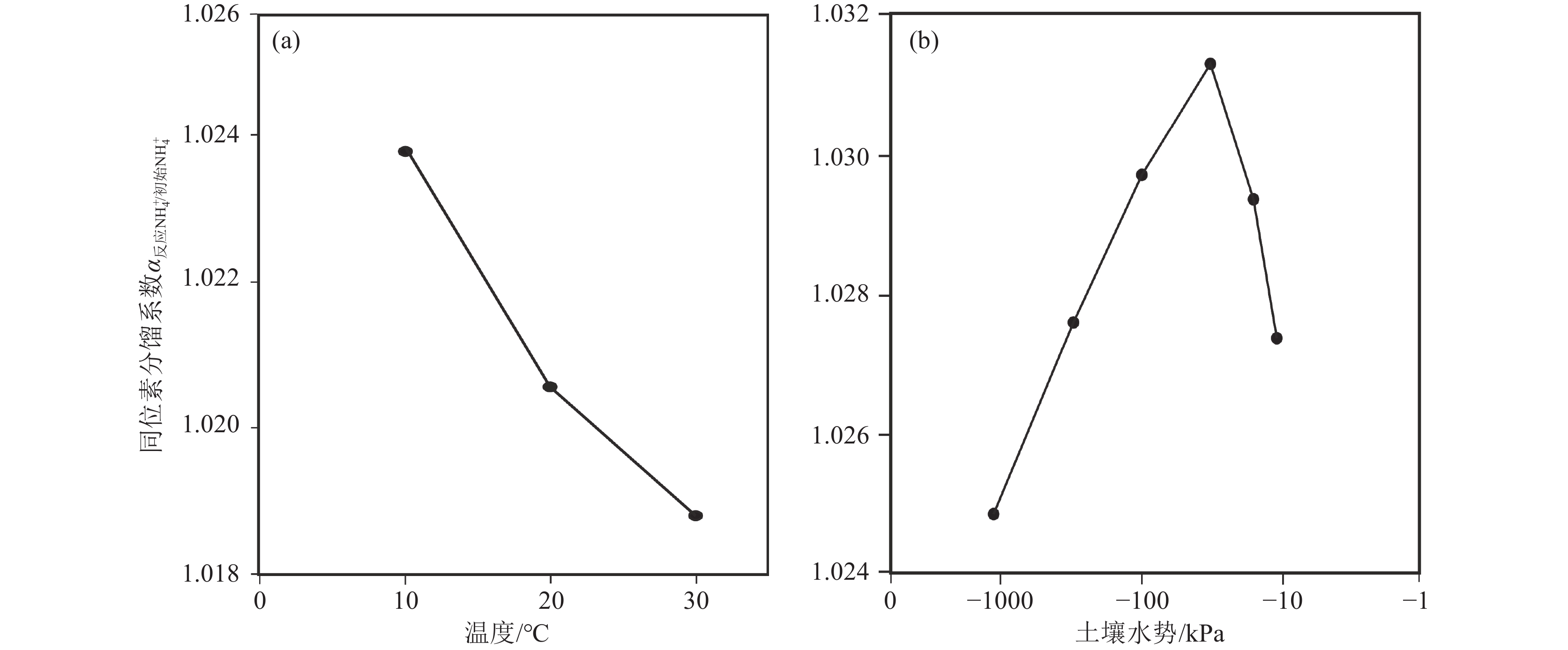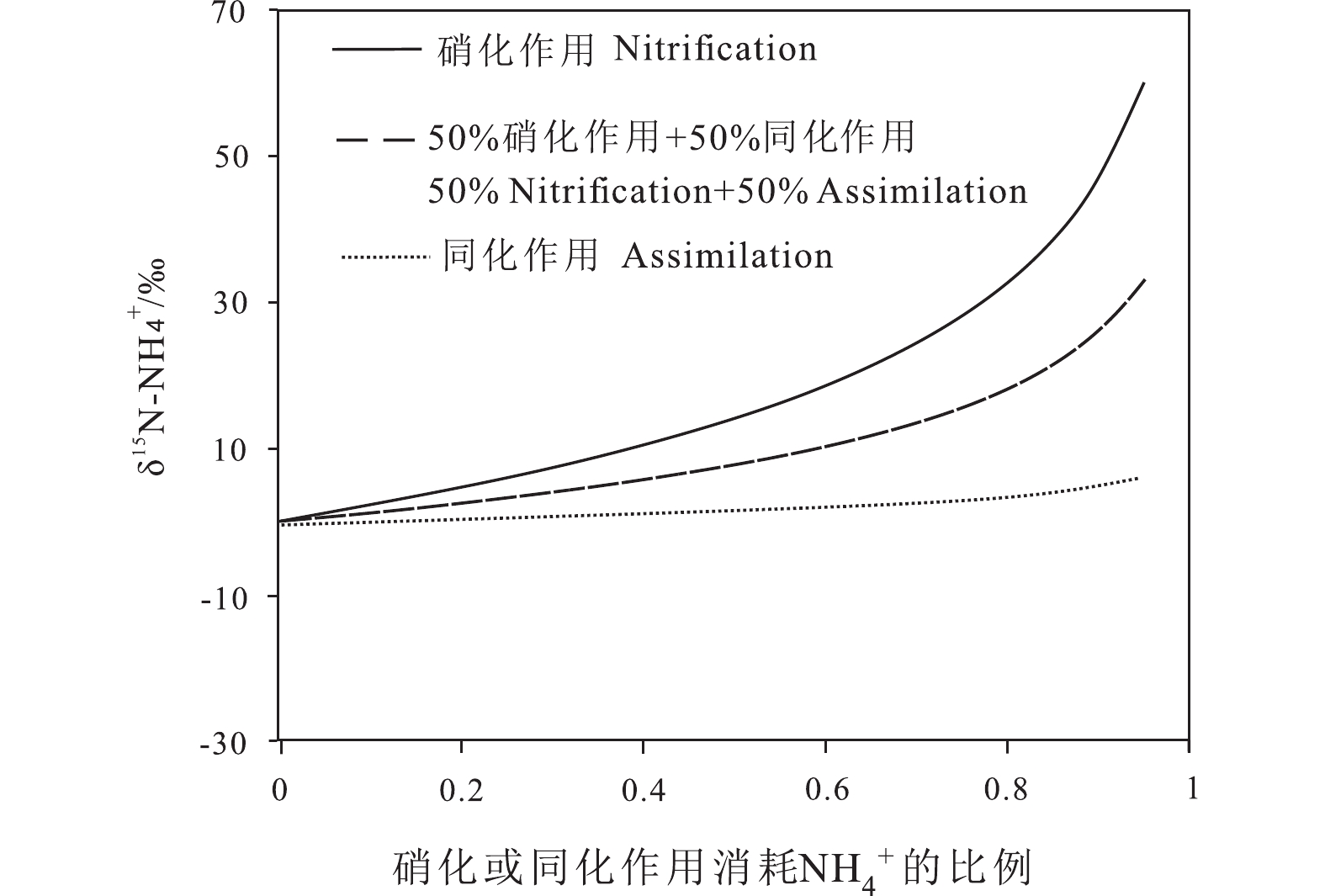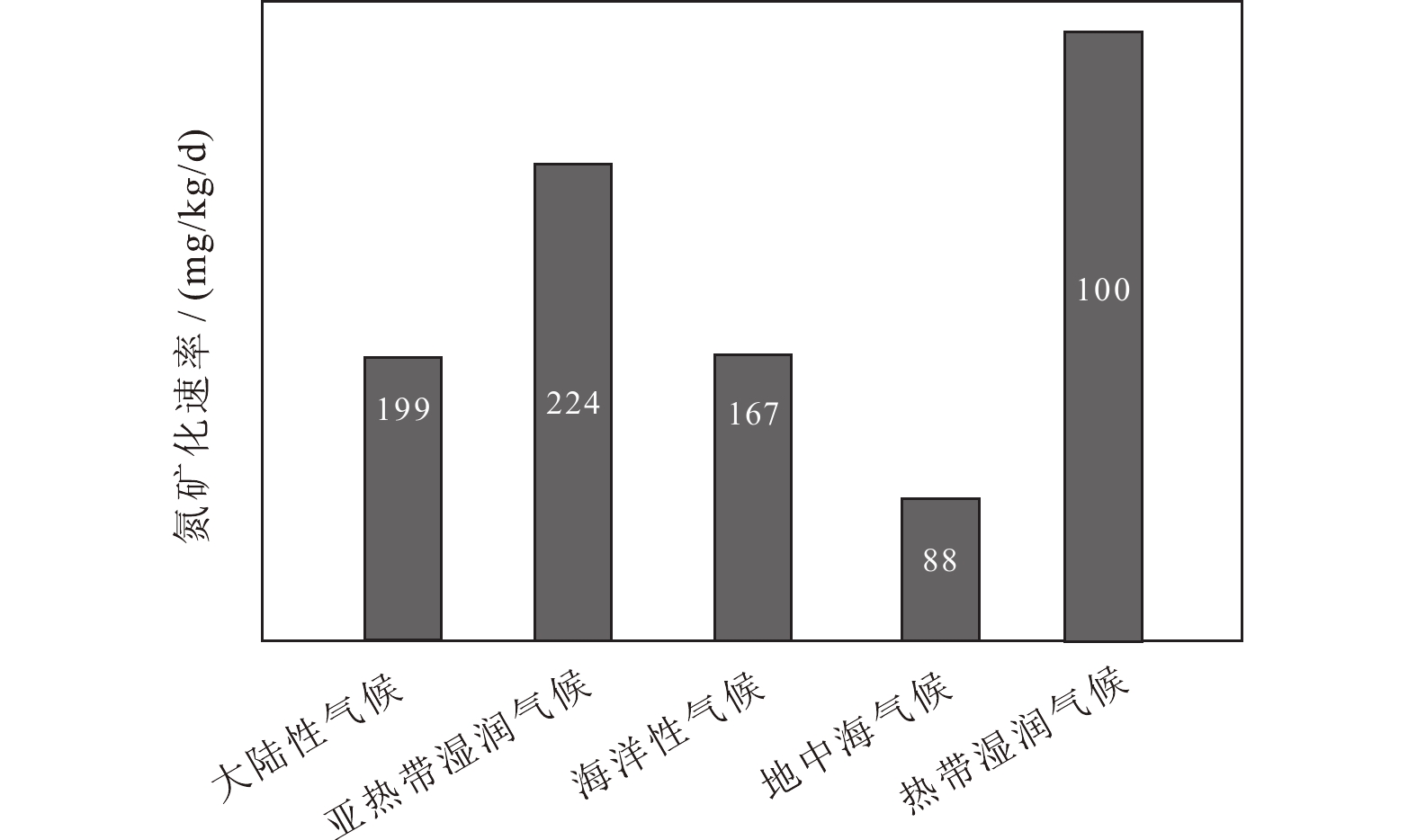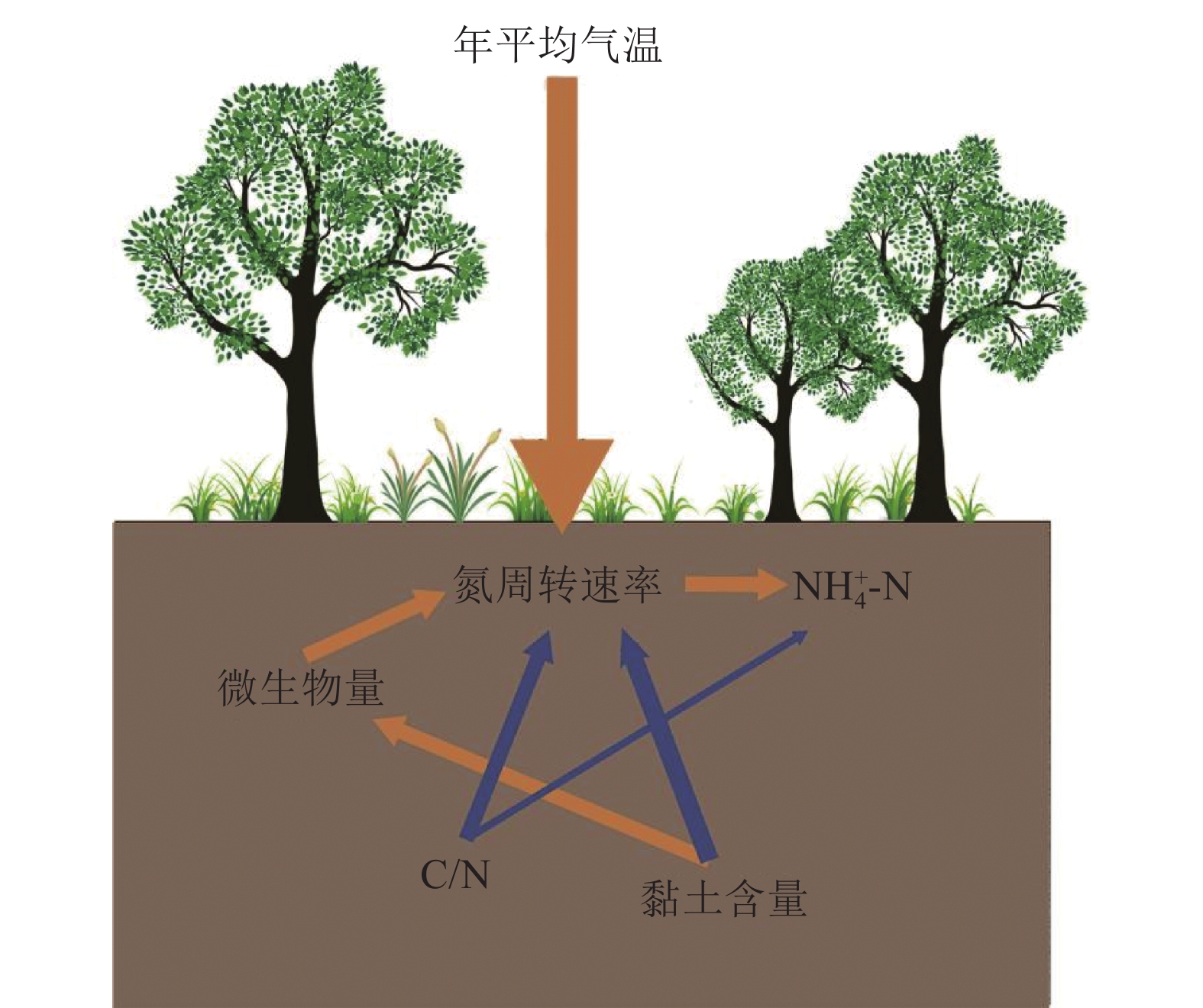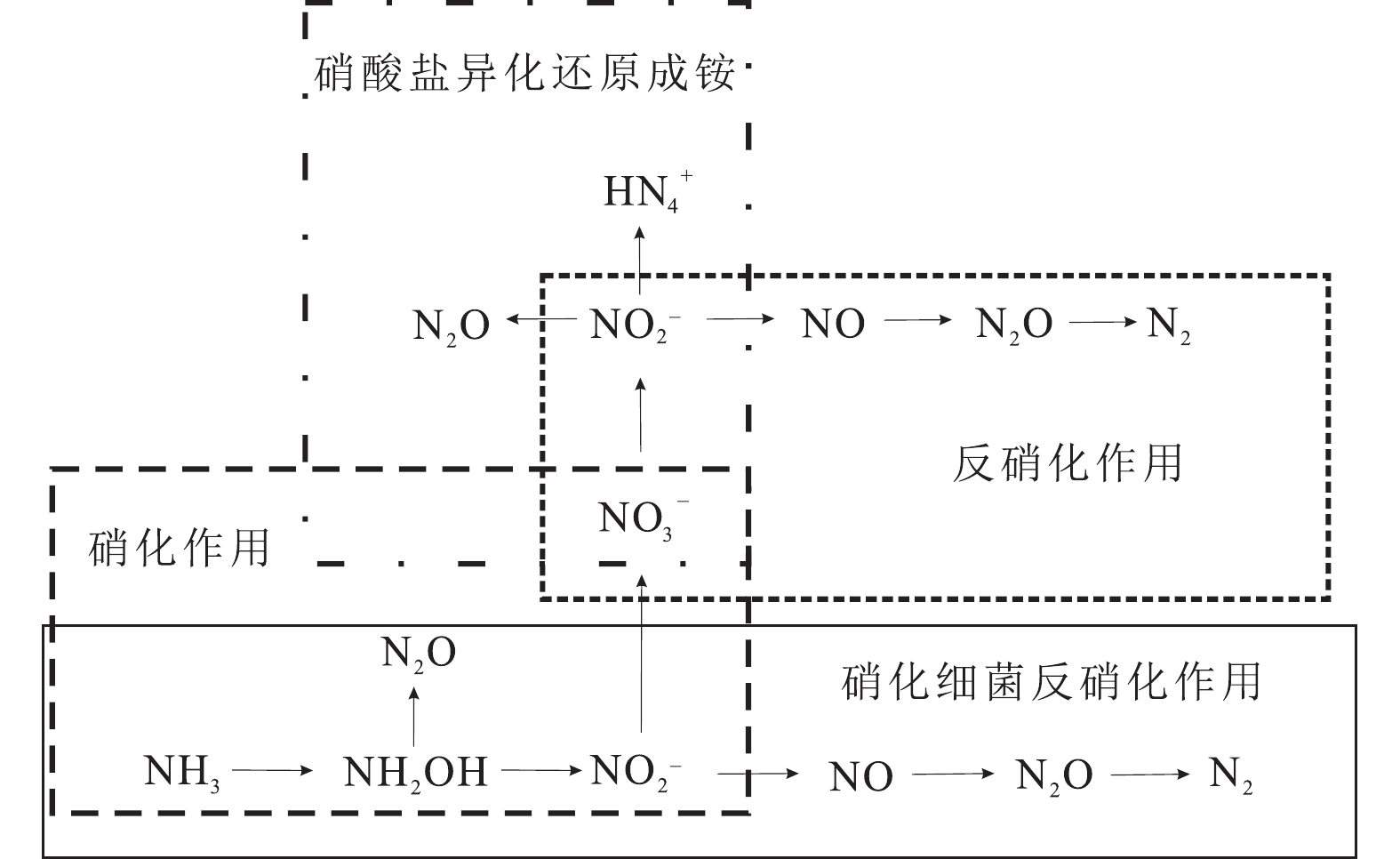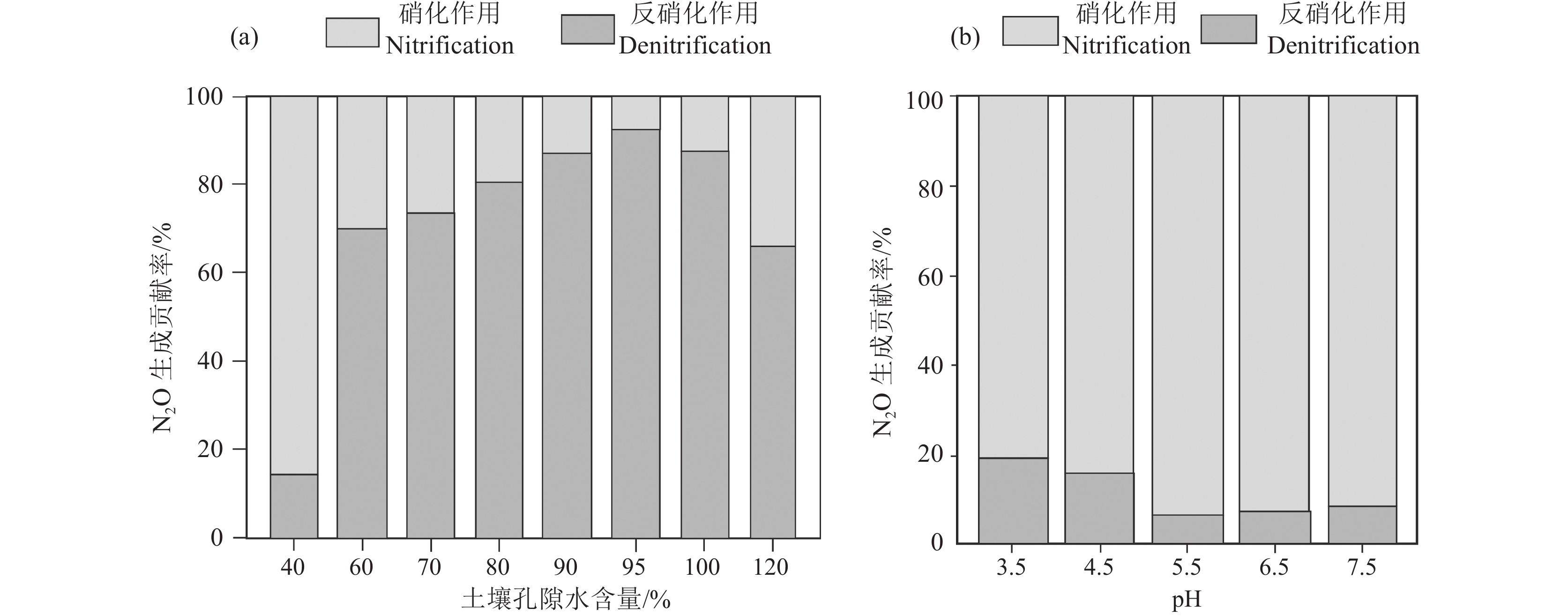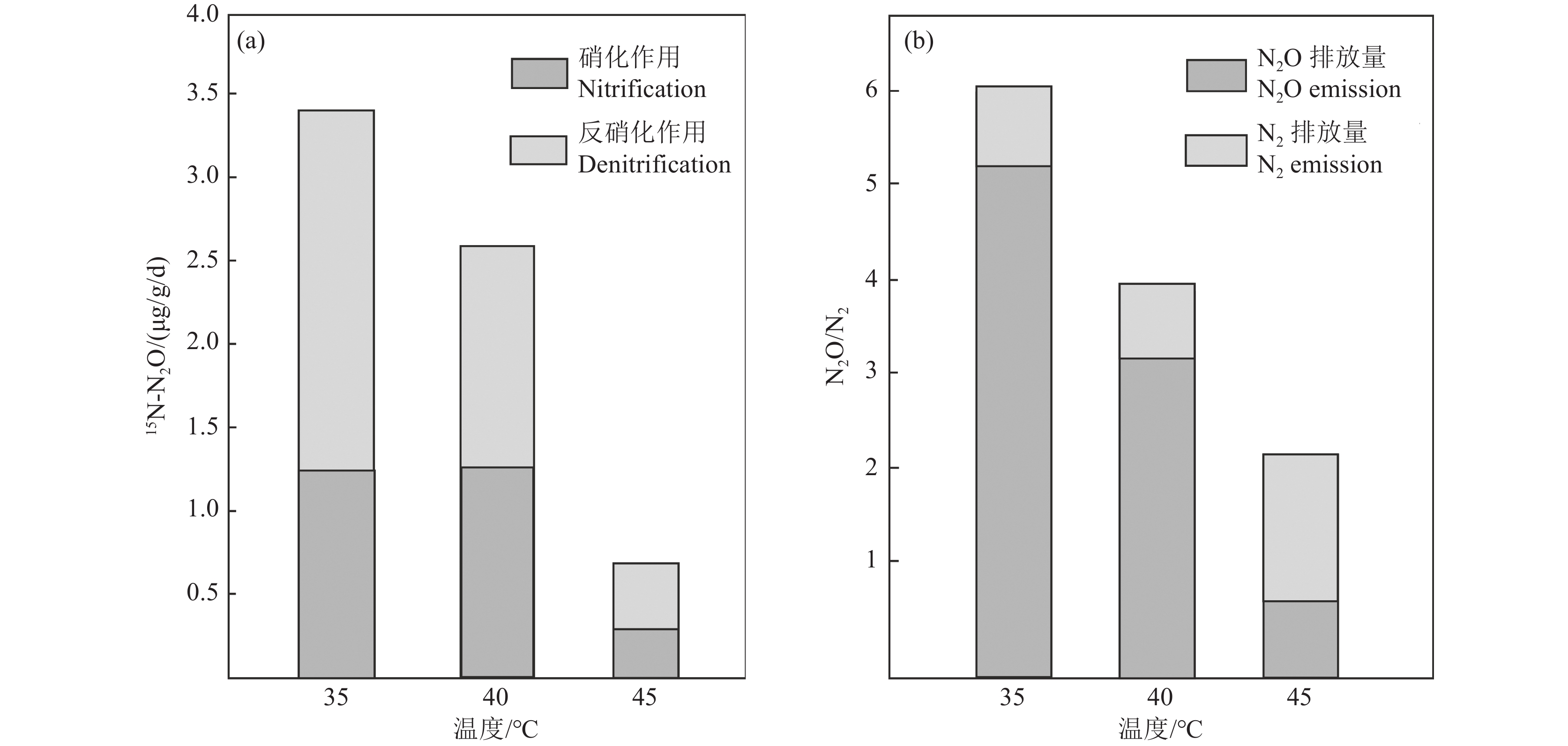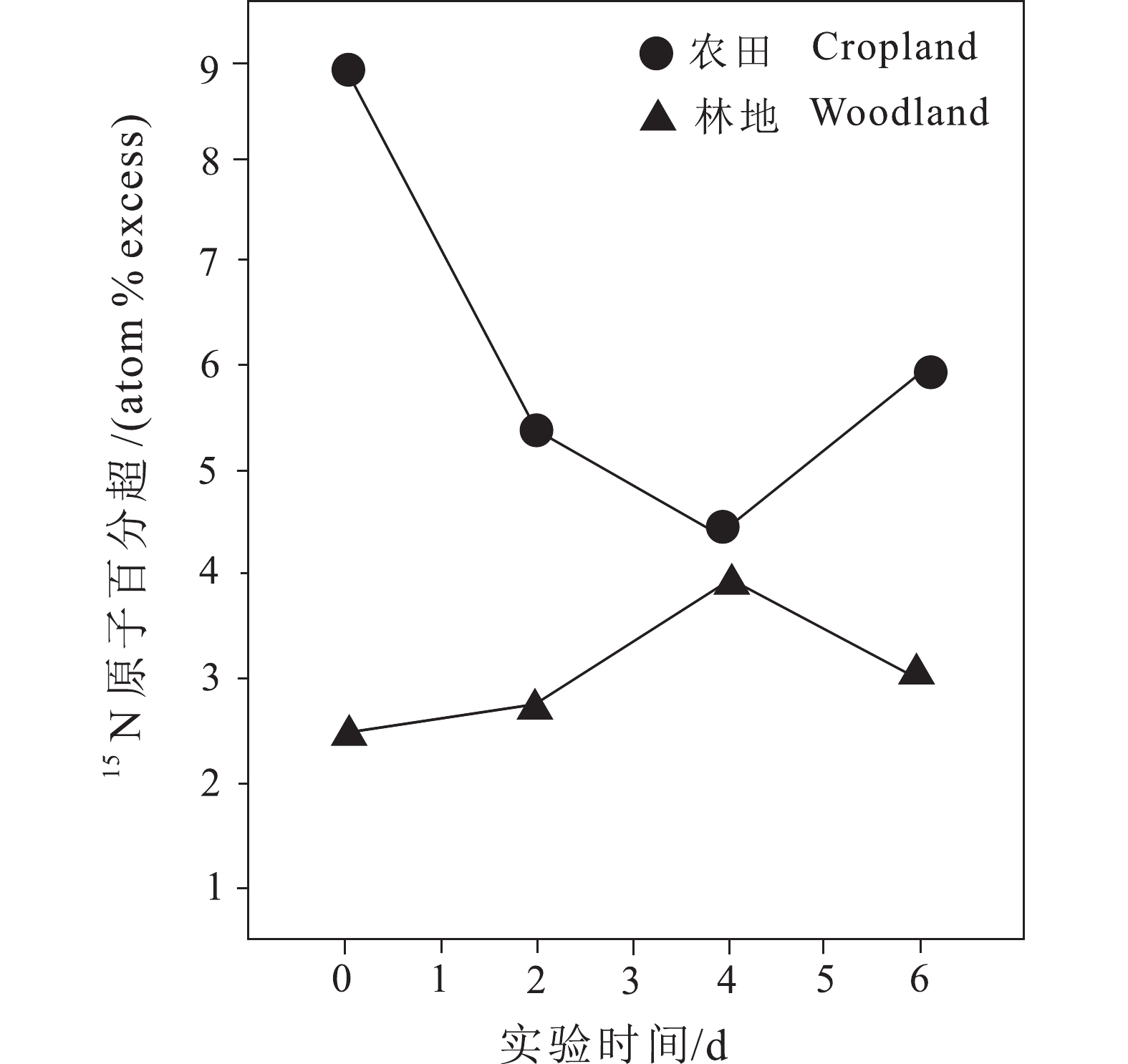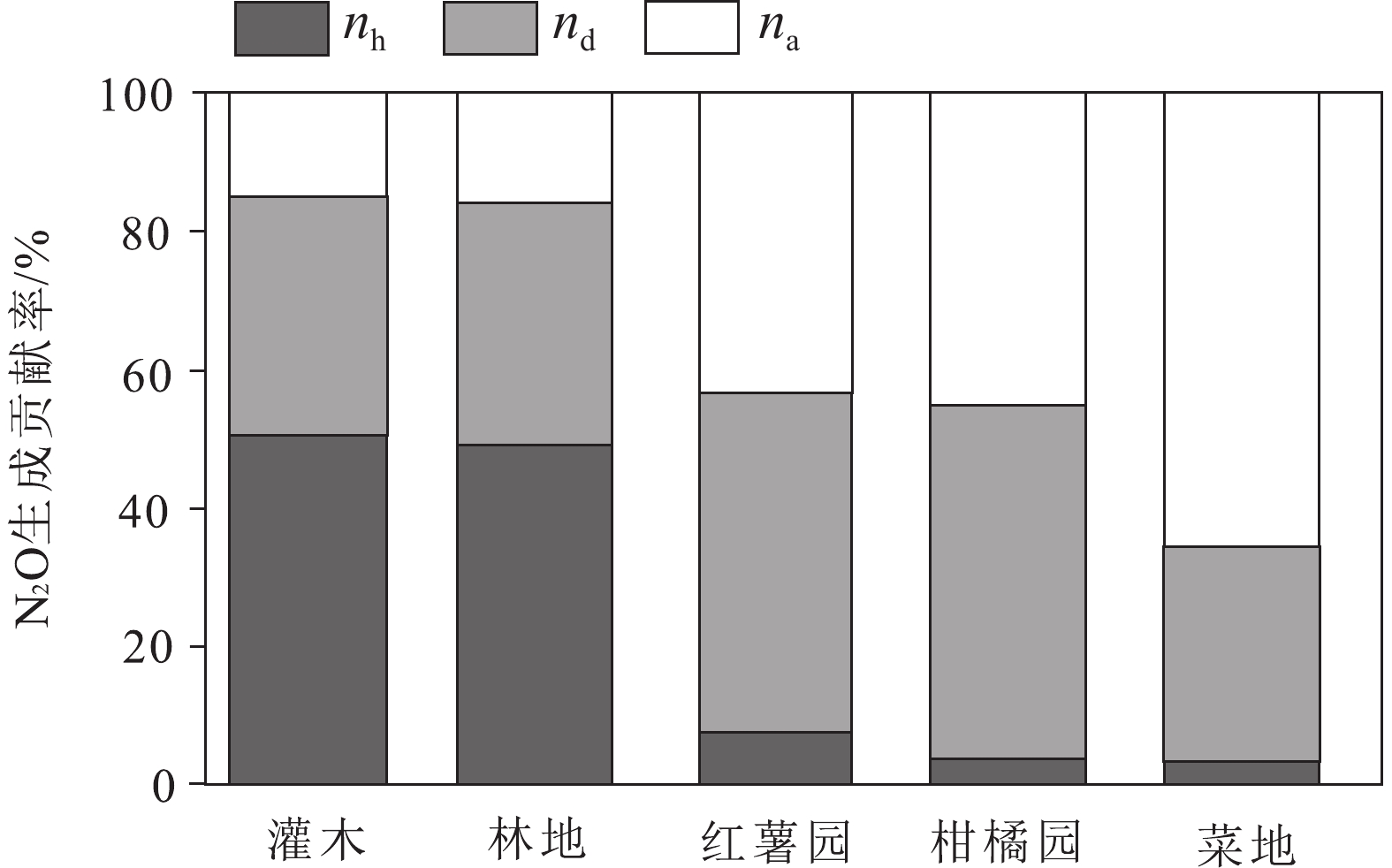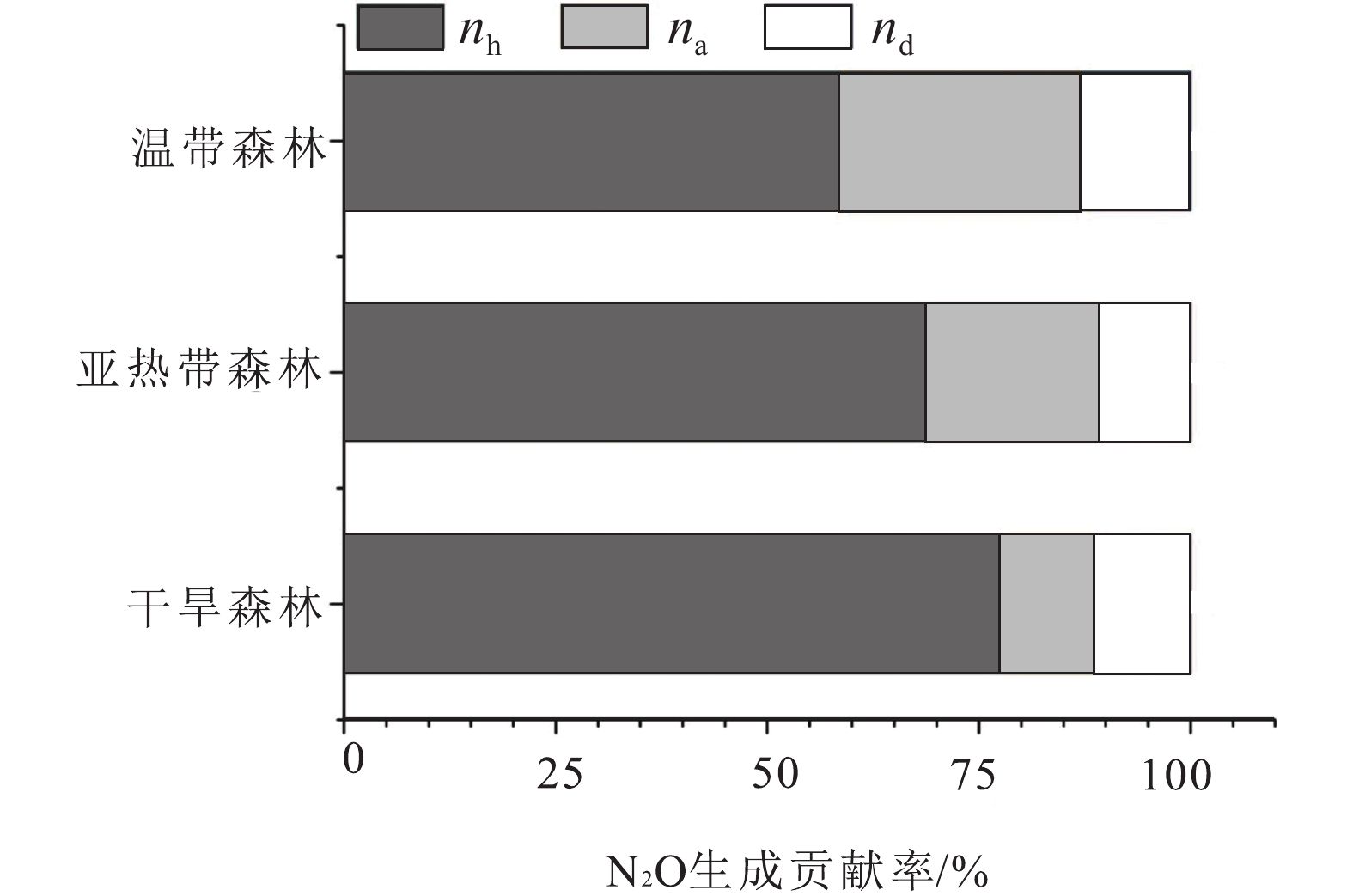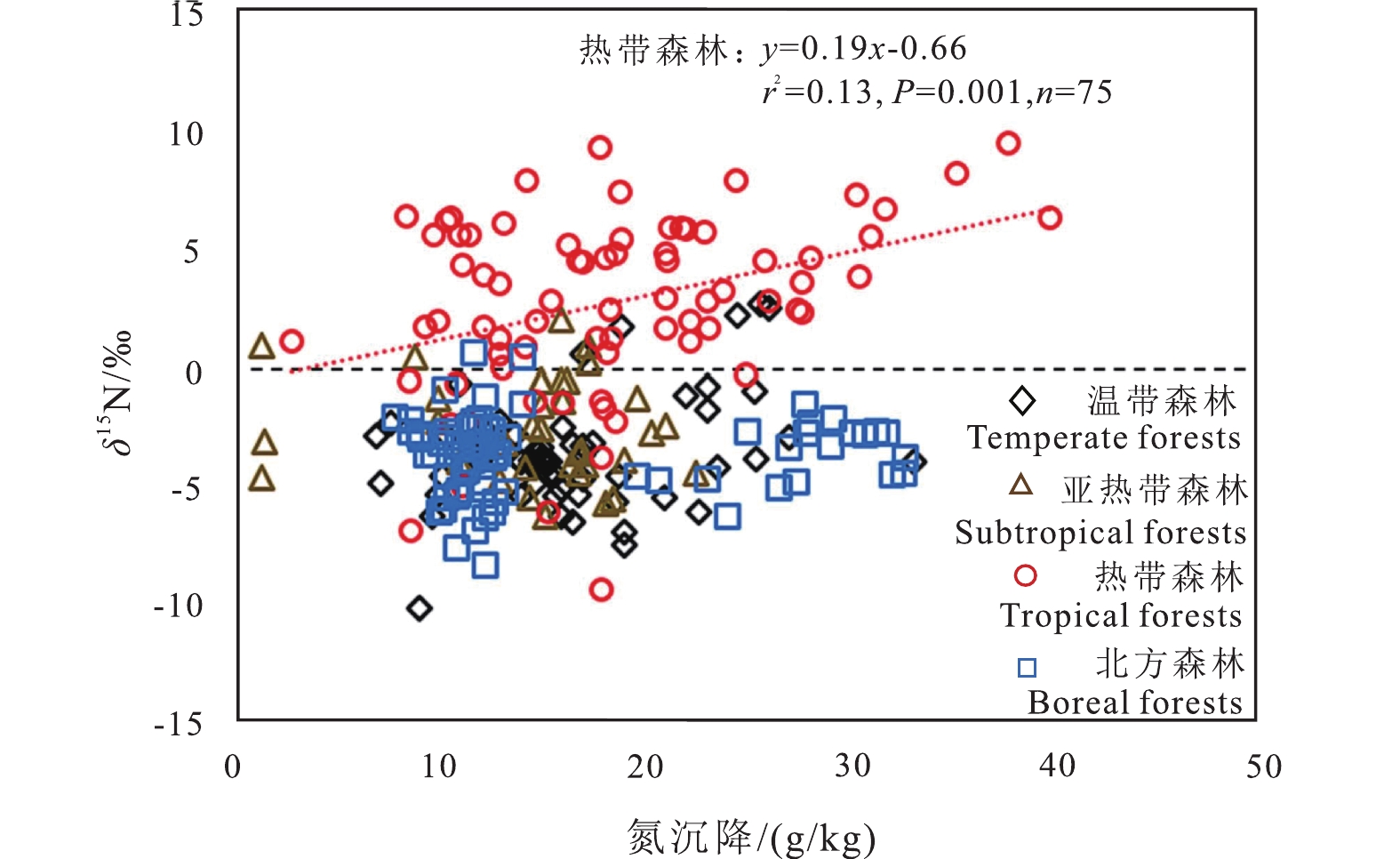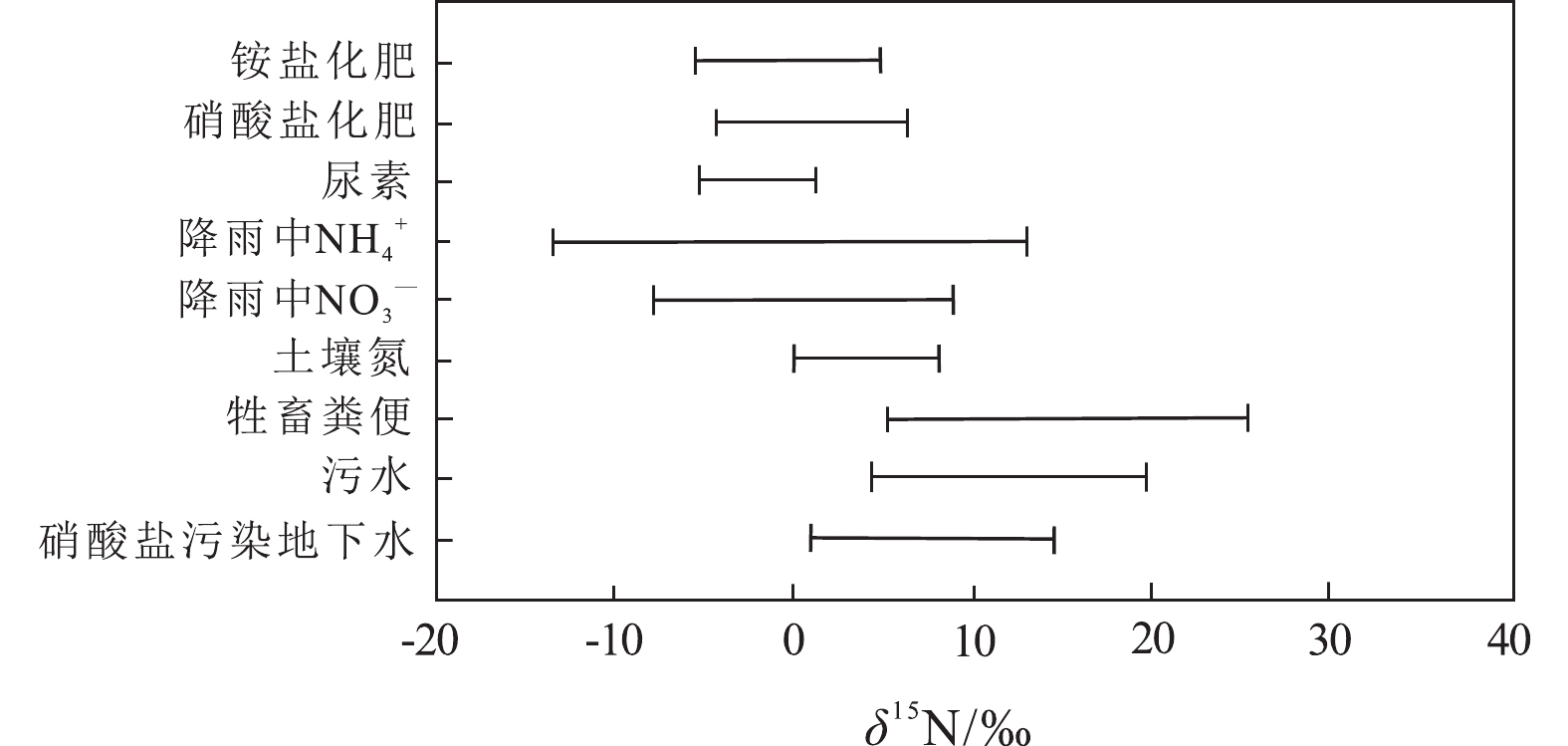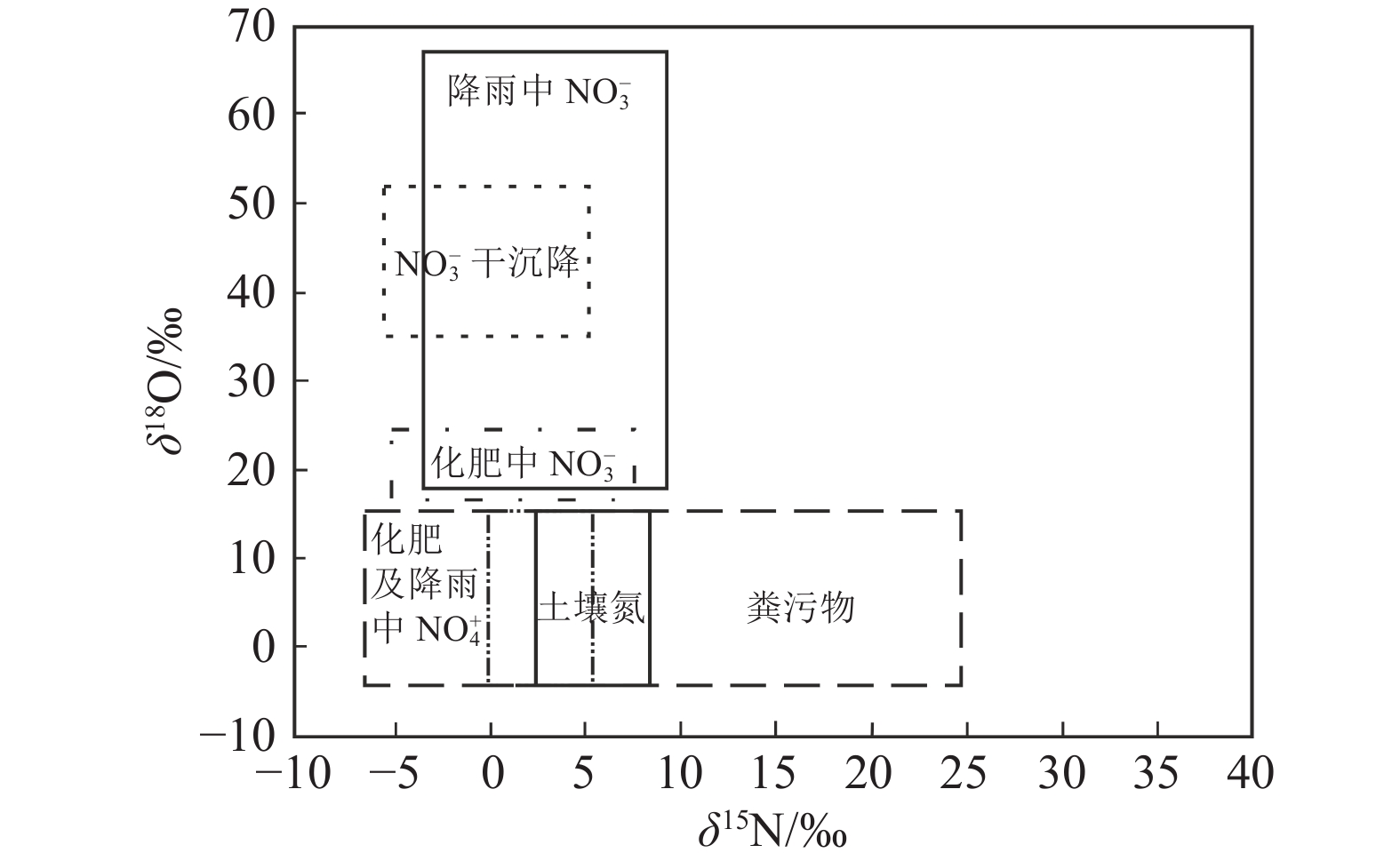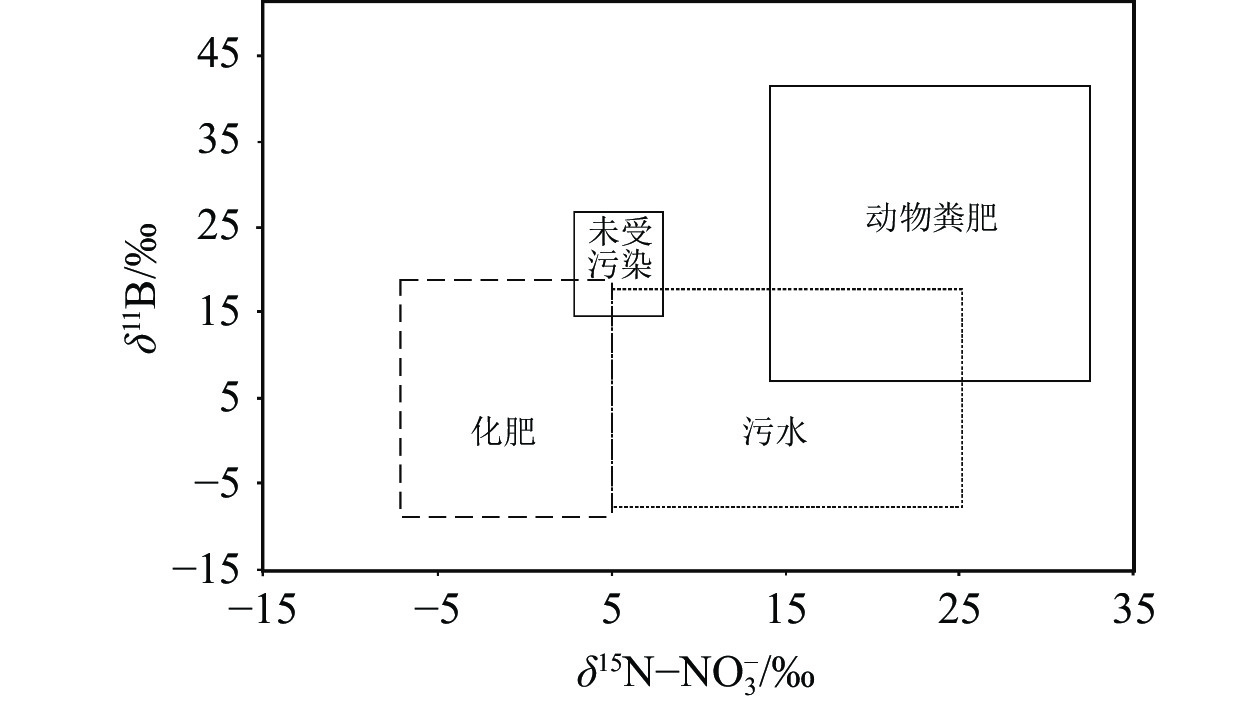Nitrogen isotope fractionation mechanism, analysis measurement tracer technology and its application in ecological environment
-
摘要:
研究目的 氮(N)是地球陆地生态系统中的关键营养元素,也是引起水体富营养化的污染元素之一。随着分析测试技术的不断提高,氮稳定同位素技术已经发展成为一种常用的研究方法和分析手段,在氮的生物地球化学循环、水体富营养化和地下水污染来源识别等方面广泛应用。
研究方法 本文查阅近年来国内外生态环境领域氮稳定同位素的相关文献,综述了氮同位素分馏机制、氮同位素分析技术以及氮同位素在生态环境中应用的研究现状。
研究结果 (1)氮同位素质谱分析技术与氮同位素示踪技术目前已经建立了成熟体系。(2)硝化作用与反硝化作用是土壤氮转化循环的主要机制,生物固氮实现氮的输入,而植物或微生物产生含氮气体或矿化作用是氮输出的主要途径,并伴随着不同程度的氮同位素分馏效应。(3)氮同位素可以用来测定土壤氮素周转速率、N2O排放途径与生物固氮量、指示大气氮沉降变化、探究植物与土壤的相互作用及确定植物对氮素的吸收利用、识别农作物产地与水体、大气的氮污染来源。
结论 未来应将研究重点放在提升氮循环过程中不确定性来源的定量检测能力,确定未被发现的氮输入、积累和损失途径,完善并发展生态系统氮循环模型。
Abstract:This paper is the result of environmental geological survey engineering.
Objective Nitrogen (N) is a key nutrient across Earth's terrestrial ecosystems and one of the pollution elements that cause water eutrophication. Owing to the continuous improvements of analysis and testing techniques, nitrogen stable isotope technology has developed into a common research method and analysis mean, and has been widely used in nitrogen biogeochemical cycle, water eutrophication and groundwater pollution source identification.
Methods In this paper, the relevant literatures on nitrogen stable isotope in the field of ecological environment domestic and overseas in recent years were reviewed, and the research status of nitrogen isotope fractionation mechanism, nitrogen stable isotope analysis technology and nitrogen isotope applications in ecological environment were summarized, the development of remediation technologys of nitrate pollution in groundwater were briefly described.
Results (1) A mature system of nitrogen isotope mass spectrometry and nitrogen isotope tracer technology has been established. (2) Nitrification and denitrification are the main mechanisms of soil nitrogen conversion cycle. Nitrogen input is realized by biological nitrogen fixation, and nitrogen output is mainly through nitrogen gas or ammoniation produced by plants or microorganisms, which is accompanied by different degrees of nitrogen isotope fractionation. (3) Nitrogen isotopes can be used to measure soil nitrogen turnover rates and N2O emission rates, improve biological nitrogen fixation, indicate changes in atmospheric nitrogen deposition, investigate the interaction between plant and soil and determine nitrogen uptake and utilization by plants, and identify crop area sources and pollution in groundwater and atmosphere.
Conclusions Future researches should focus on improving the ability of quantitative detection of uncertainty sources in the nitrogen cycle, identifying undiscovered nitrogen input, accumulation and loss pathways, and perfecting and developing ecosystem nitrogen cycle model.
-

-
图 1 主要氮循环过程中的同位素分馏效应(ε,δ15N/‰)(据张金波等,2022)
Figure 1.
图 3 温度(a,据Yun et al., 2011)和湿度影响下土壤硝化过程氮同位素分馏系数变化(b,据Yun and Ro, 2014)
Figure 3.
图 4 δ15N−NH4+随NH4+受硝化作用和同化作用影响的变化(据Choi et al., 2017)
Figure 4.
图 10 不同生态系统氮矿化速率(N为观测值个数;据Elrys et al., 2021)
Figure 10.
图 11 土壤N2O产生途径(据Baggs, 2008)
Figure 11.
图 12 土壤孔隙水含量(a,据Wang et al., 2023)与pH(b,据Zhang et al., 2021)对硝化和反硝化作用对N2O生成贡献的影响
Figure 12.
图 13 土壤15N−N2O(a)与土壤排放气体N2O/N2(b)随温度变化(据Lai et al., 2019)
Figure 13.
图 14 不同土壤类型产生N2O的15N丰度(据Zhang et al., 2017)
Figure 14.
图 15 不同土壤类型N2O产生途径nh、na和nd分别是异养硝化、自养硝化和反硝化对N2O生成的贡献(据Zhang et al., 2018)
Figure 15.
图 17 作物生物固氮过程(据Guo et al., 2023)
Figure 17.
图 18 氮沉降与不同地区森林叶片δ15N的相关性(据Choi et al., 2023)
Figure 18.
图 19 北美森林(a)与热带森林(b)不同树种树轮δ15N变化趋势比较(据王可逸等,2021)
Figure 19.
图 20 温带地区(a)和冷温带白桦和泥炭藓(b)吸收氮偏好(据Gao et al., 2020)
Figure 20.
图 21 不同污染来源δ15N值分布(据Xue et al., 2009)
Figure 21.
图 22 不同污染来源δ15N与δ18O值分布(据Kendall, 1998)
Figure 22.
图 23 典型污染来源δ15N与δ11B值分布(据Sankoh et al., 2022)
Figure 23.
表 1 不同细菌在不同实验条件下反硝化作用的氮同位素分馏效应(ε,δ 15N/‰)
Table 1. Nitrogen isotope fractionation effect of denitrification by different bacteria under different experimental conditions (ε, δ 15N/‰)
表 2 同种细菌在不同实验条件下反硝化作用的氮同位素分馏效应(ε,δ 15N/‰)(据Frey et al., 2014;Treibergs and Granger, 2017)
Table 2. Nitrogen isotope fractionation effect of denitrification by the same bacteria under different experimental conditions (ε, δ 15N/‰) (after Frey et al., 2014; Treibergs and Granger, 2017)
细菌 温度/
℃NO3−浓度/
mM细菌数量/
个氮同位素分馏效应
(ε,δ 15N/‰)脱氮副球菌 20 0.2 4 22.90 20 0.2 4 25.80 20 1 3 33.00 20 1 5 31.50 硫单胞菌 15 5 5 24.29 15 5 4 21.17 15 1 5 17.69 10 1 5 13.08 10 1 5 13.08 表 3 不同生态系统反硝化作用氮同位素分馏效应
Table 3. Denitrification effect of nitrogen isotope fractionation in different ecosystems
表 4 不同生态系统平均硝化速率(据Li et al., 2020)
Table 4. Average nitrification rate in different ecosystems (after Li et al., 2020)
生态系统 平均硝化速率/(mg/kg/d) 观测数据/个 农田 3.82 1423 森林 2.58 841 草地 1.70 368 湿地 3.29 80 表 5 不同N2O产生过程中δ15N与SP值(据Decock and Six, 2013)
Table 5. Different N2O production processes of δ15N and SP values (after Decock and Six, 2013)
N2O产生过程 δ15N/‰ SP 氨氧化细菌羟氨氧化 −0.3±3.4 33.0±1.6 甲烷氧化菌羟氨氧化 1.9±1.9 32.7±5.0 氨氧化细菌氨氧化 −45.5±2.3 31.4±4.2 非生物氧化 −5.8±9.2 29.9±1.5 真菌反硝化作用 −9.9±6.7 35.2±4.3 反硝化作用 −13.8±4.9 −2.2±3.2 硝化细菌反硝化作用 −29.0±6.0 −1.0±4.3 表 6 全球范围内不同气候带和海拔范围内的土壤δ15N统计特征值(据昝麒麟等,2022)
Table 6. Number of samples and statistical descriptions of soil δ15N on global scale in different climate zones and elevation ranges (after Zan Qilin et al., 2022)
土壤环境 土壤δ15N值/‰ 气候带 赤道气候带 5.34 干旱气候带 5.78 暖温气候带 3.91 冷温气候带 3.98 极地气候带 3.98 海拔 <500 m 4.39 500~1000 m 4.70 1000~2000 m 4.72 2000~3500 m 4.78 >3500 m 4.18 表 7 不同种类肥料δ15N值(据Choi et al., 2017)
Table 7. δ15N values of different kinds of fertilizers (after Choi et al., 2017)
肥料种类 δ15N/‰ 平均δ15N/‰ 合成肥料 尿素 −5.9~1.9 −1.2 ± 0.4 硫酸铵 −3.9~6.6 −0.5 ± 0.7 硝酸铵 −1.7~2.6 0.1 ± 0.5 牲畜粪便 牛粪 3.5~16.5 8.4 ± 0.9 猪粪 4.4 ~11.3 6.7 ± 1.0 马粪 7.2~11.8 9.5 ± 2.3 家禽粪便 2.7~14.6 7.1 ± 1.5 表 8 利用氮同位素技术提高作物相关微生物固氮的研究现状
Table 8. Research status of nitrogen isotope technology to improve nitrogen fixation by crop−related microorganisms
作物种类 研究现状 参考文献 水稻 利用15N直接标记测定稻田固氮量,发现水稻种植极大地促进了固氮菌nifH基因的表达,提高了固氮菌的固氮活性,增加了稻田各层土壤的固氮量 张燕辉等(2021) 玉米 利用15N自然丰度法进行实验证明,墨西哥玉米品种ierra Mixe根部产生的黏液中具有活性nif基因的细菌菌株,可以满足该玉米品种氮需求的29%~82% Van Deynze et al. (2018) 将氮肥替换为30% atom15N标记的(NH4)2SO4,测定γ−变形杆菌通过生物固氮贡献了玉米茎中积累的11.8%的总氮 Zhang et al. (2022) 甘蔗 利用15N自然丰度法确定接种重氮营养菌使RB92579和RB2003两种甘蔗品种的生物固氮量分别增加了50和17 kg/hm2 Martins et al. (2020) 通过对植株组织、植株产物和叶绿素的15N同位素稀释,证实了克莱伯菌与甘蔗共生,能缓解氮素缺乏症的发生 Luo et al. (2015a) 豆类 利用15N贫化法确定接种根瘤菌有利于提高籽粒固氮和籽粒重。与Apore品种相比,Ouro Negro品种的根瘤数量和重量以及从大气中获得的氮量更高 Silva et al. (2017) 表 9 不同大陆和气候带森林的大气氮沉降速率(据Schwede et al., 2018)
Table 9. Atmospheric N deposition rates for forests in different continents and climate zones (after Schwede et al., 2018)
气候带 地区 氮沉降速率/(kg/hm2/a) 亚洲 7.8 温带 美洲 5.4 欧洲 10.8 亚洲 29.3 北美洲 7.2 亚热带 南美洲 10.5 欧洲 10.5 非洲 7.9 热带 亚洲 11.8 北美洲 7.4 南美洲 5.8 欧洲 7.1 表 10 不同地区植物叶片的δ15N和氮含量(据Choi et al., 2023)
Table 10. δ15N and N concentration of foliage in different zones (after Choi et al., 2023)
气候带 叶片δ15N/‰ 叶片氮含量/(g/kg) 温带 −2.4±2.2 16.4±5.2 亚热带 −2.5±2.0 14.6±5.0 热带 1.6±4.3 18.5±7.3 表 11 入侵物种对土壤有效氮的影响
Table 11. Effects of invasive species on soil available nitrogen
地区 入侵物种 对土壤有效氮影响 参考文献 北美 矢车菊 根系分泌儿茶素显著抑制土壤硝化速率,导致入侵地土壤NO3−浓度降低 Thorpe and Callaway,2011 北美 虎杖 分泌单宁抑制土壤的氮矿化作用,导致土壤无机氮浓度较低,总游离氨基酸和可溶性有机氮的浓度升高 Tharayil et al.,2013 中国北方 火炬树 提高土壤的硝化速率,土壤NO3−含量升高,土壤NH4+含量降低 黄乔乔等,2013 海南 金钟藤 土壤NO3−、NH4+含量升高 纵熠等,2015 澳大利亚 须芒草 提高土壤氨化作用,抑制土壤氮硝化,土壤NH4+含量增加 Rossiter−Rachor et al.,2009 表 12 不同地区小麦样品δ15N值(据Luo et al., 2015b)
Table 12. δ15N values of wheat samples from different regions (after Luo et al., 2015b)
来源 δ15N/‰ 美国 3.04±0.79 加拿大 2.13±0.70 澳大利亚 7.25±1.18 中国 2.45±0.5 表 13 不同地区谷物δ15N与δ13C值(据Wu et al., 2015)
Table 13. δ15N and δ13Cvalues of different cereal grains from different origins (after Wu et al., 2015)
谷物 平均δ15N/‰ 平均δ13C/‰ 黑龙江 山东 江苏 黑龙江 山东 江苏 水稻 3.070 3.434 3.221 −26.285 −26.946 −27.578 大豆 1.365 1.462 1.388 −23.679 −25.642 −26.102 小米 1.098 1.251 1.112 −11.985 −12.346 −12.897 小麦 1.827 1.934 1.850 −22.843 −25.694 −25.162 玉米 0.237 0.432 0.292 −10.965 −10.444 −11.292 表 14 不同排放源大气氮δ15N值(据Choi et al., 2023)
Table 14. Atmospheric nitrogen δ15N values of different emission sources (after Choi et al., 2023)
来源 δ15N−NOx/‰ δ15N−NH3/‰ 生物质燃烧 0.2 化石燃料燃烧 11.7 −13 施肥土壤 −32.5 −40.5 牲畜粪便 −19.3 −27.9 车辆 −8.2 −21.7 天然气燃烧 −16.7 有机废物 −37.8 -
[1] Ahmed M, Aly A, Gomaa H. 2012. Developed method for nitrate extraction and purification to measure δ18O−NO3−composition in water[J]. Arab Journal of Nuclear Sciences and Applications, 45(4): 1−13.
[2] Alexander B, Mickley L J. 2015. Paleo−perspectives on potential future changes in the oxidative capacity of the atmosphere due toclimate change and anthropogenic emissions[J]. Current Pollution Reports, 1(2): 57−69. doi: 10.1007/s40726-015-0006-0
[3] An H, Li G Q. 2015. Efects of grazing on carbon and nitrogen in plants and soils in a semiarid desert grassland, China[J]. Journal of Arid Land, 7(3): 341−349. doi: 10.1007/s40333-014-0049-x
[4] Aranibar J N, Otter L, Macko S A, Epstein H E, Otter L, Dowty P R. 2004. Nitrogen cycling in the soil−plant system along a precipitation gradient in the Kalahari sands[J]. Global Change Biology, 10(3): 359−373. doi: 10.1111/j.1365-2486.2003.00698.x
[5] Archana A, Thibodeau B, Geeraert N, Xu M N, Kao S J, Baker D M. 2018. Nitrogen sources and cycling revealed by dual isotopes of nitrate in a complex urbanized environment[J]. Water Research, 142: 459−470. doi: 10.1016/j.watres.2018.06.004
[6] Baggs E M. 2008. A review of stable isotope techniques for N2O source partitioning in soils: Recent progress, remaining challenges and future considerations[J]. Rapid Communications in Mass Spectrometry, 22: 1664−1672. doi: 10.1002/rcm.3456
[7] Bai X, Hu X J, Liu J J, Wei D, Zhu P, Cui X, Zhou B K, Chen X L, Liu J D, Jin J, Liu X B, Wang G H. 2022. Ammonia oxidizing bacteria dominate soil nitrification under different fertilization regimes in black soils of northeast China[J]. European Journal of Soil Biology, 111: 103410. doi: 10.1016/j.ejsobi.2022.103410
[8] Berner A H, Felix J D. 2020. Investigating ammonia emissions in a coastal urban airshed using stable isotope techniques[J]. The Science of the Total Environment, 707: 134952. doi: 10.1016/j.scitotenv.2019.134952
[9] Booth M S, Stark J M, Rastetter E. 2005. Controls on nitrogen cycling in terrestrial ecosystems: A synthetic analysis of literature data[J]. Ecological Monographs, 75(2): 139−157. doi: 10.1890/04-0988
[10] Bork E W, Attaeianb B, Cahillc J F, Changd S X. 2019. Soil nitrogen and greenhouse gas dynamics in a temperate grassland under experimental warming and defoliation[J]. Soil Science Society of America Journal, 83(3): 780−790. doi: 10.2136/sssaj2018.04.0150
[11] Briand C, Plagnes, V, Sebilo M, Louvat P, Chesnot T, Schneider M, Ribstein P, Marchet P. 2013. Combination of nitrate(N, O) and boron isotopic ratios with microbiological indicators for the determination of nitrate sources in karstic groundwater[J]. Environmental Chemistry, 10(5): 365−369. doi: 10.1071/EN13036
[12] Briand C, Sebilo M, Louvat P, Chesno T, Vaury V, Schneider M, Plagnes V. 2017. Legacy of contaminant N sources to the NO3−signature in rivers: a combined isotopic (δ15N−NO3−, δ18O−NO3−, δ11B) and microbiological investigation[J]. Scientific Reports, 7: 41703. doi: 10.1038/srep41703
[13] Buchen C, Lewicka−Szczebak D, Flessa H, Well R. 2018. Estimating N2O processes during grassland renewal and grassland conversion to maize cropping using N2O isotopocules[J]. Rapid Communications in Mass Spectrometry, 32(13): 1053−1067. doi: 10.1002/rcm.8132
[14] Byrnes R C, Nùnez J, Arenas L, Rao I, Trujillo C, Alvarez C. 2017. Biological nitrification inhibition by Brachiaria grasses mitigates soil nitrous oxide emissions from bovine urine patches[J]. Soil Biology & Biochemistry, 107(1): 156−163.
[15] Cao Yacheng, Zhang Jinbo, Wen Teng. 2018. Application of Stable Isotope Tracer Technology and Mass Spectrometry in Soil, Ecology and Environment Research [M]. Beijing: Science Press (in Chinese).
[16] Chalk P, Smith C. 2021. On inorganic N uptake by vascular plants: Can 15N tracer techniques resolve the NH4+ versus NO3− “preference” conundrum?[J]. European Journal of Soil Science, 72(4): 1762−1779. doi: 10.1111/ejss.13069
[17] Chapagain T, Riseman A. 2014. Barley−pea intercropping: Effects on land productivity, carbon and nitrogen transformations[J]. Field Crops Research, 166: 18−25. doi: 10.1016/j.fcr.2014.06.014
[18] Chen Z M, Ding W X, Xu Y H, Müller C, Rütting T, Yu H Y, Fan J L, Zhang J B, Zhu T B. 2015. Importance of heterotrophic nitrification and dissimilatory nitrate reduction to ammonium in a cropland soil: Evidences from a 15N tracing study to literature synthesis[J]. Soil Biology and Biochemistry, 91: 65−75. doi: 10.1016/j.soilbio.2015.08.026
[19] Chen Z X, Liu G, Liu W G, Lam M H W, Liu G J, Yin X B. 2012. Identification of nitrate sources in Taihu Lakeand its major inflow rivers in China, using δ15N−NO3− and δ18O−NO3− values[J]. Water Science & Technology, 66(3): 536−542.
[20] Cheng Y, Wang J, Chang S X, Cai Z C, Müller C, Zhang J B. 2019. Nitrogen deposition affects both net and gross soil nitrogen transformations in forest ecosystems: A review[J]. Environmental Pollution (Barking, Essex: 1987), 244: 608−616.
[21] Cheng Y, Wang J, Wang S Q, Zhang J B, Cai Z C. 2014. Effects of soil moisture on gross N transformations and N2O emission in acid subtropical forest soils[J]. Biology and Fertility of Soils, 50(7): 1099−1108. doi: 10.1007/s00374-014-0930-y
[22] Choi W J, Kwak J H, Lim S S, Park, H J, Chang S X, Lee S M, Arshad M A, Yun S I, Kim H Y. 2017. Synthetic fertilizer and livestock manure differently affect δ15N in the agricultural landscape: A review[J]. Agriculture, Ecosystems & Environment, 237: 1−15.
[23] Choi W J, Kwak J H, Park H J, Yang H I, Park S I, Xu Z, Lee S M, Lim S S, Chang S X. 2020. Land−use type, and land management and disturbance affect soil δ15N: A review[J]. Soils Sediments, 20: 3283−3299. doi: 10.1007/s11368-020-02708-x
[24] Choi W J, Lee S M, Chang S X, Ro H M. 2005. Variations of δ13C and δ15N in Pinus Densiflora tree−rings and relationship to environmental changes in eastern Korea[J]. Water Air and Soil Pollution, 164(1): 173−187.
[25] Choi W J, Park H J, Baek N, Yang H I, Kwak J H, Lee S, Park S W, Shin E S, Lim S S. 2023. Patterns of δ15N in forest soils and tree foliage and rings between climate zones in relation to atmospheric nitrogen deposition: A review[J]. Science of the Total Environment, 900: 165866. doi: 10.1016/j.scitotenv.2023.165866
[26] Choi W J, Ro H M. 2003. Differences in isotopic fractionation of nitrogen in water−saturated and unsaturated soils[J]. Soil Biology & Biochemistry, 35(3): 483−486.
[27] Cookson W R, Osman M, Marschner P, Abaye D A , Clark I, Murphy D V, Stockdale E A, Watson C A. 2007. Controls on soil nitrogen cycling and microbial community composition across land use and incubation temperature[J]. Soil Biology and Biochemistry, 39(3): 744−756.
[28] Craine J, Brookshire E, Cramer M, Hasselquist N, Koba K, Marin−Spiotta E, Wang L X. 2015. Ecological interpretations of nitrogen isotope ratios of terrestrial plants and soils[J]. Plant and Soil, 396(1/2): 1−26.
[29] Craine J M, Elmore A J, Wang L X. 2018. Isotopic evidence for oligotrophication of terrestrial ecosystems[J]. Nature Ecology & Evolution, 2: 1735−1744.
[30] Dähnke K, Thamdrup B. 2016. Isotope fractionation and isotope decoupling during anammox and denitrification in marine sediments[J]. Limnology and Oceanography, 61(2): 610−624. doi: 10.1002/lno.10237
[31] Decock C, Six J. 2013. How reliable is the intramolecular distribution of 15N in N2O to source partition N2O emitted from soil?[J]. Soil Biology and Biochemistry, 65: 114−127. doi: 10.1016/j.soilbio.2013.05.012
[32] Denk T R A, Butterbach−Bahl K, Kiese R, Wolf B, Mohn J, Harris E Decock C, Lewicka−Szczebak Dominika. 2017. The nitrogen cycle: A review of isotope effects and isotope modeling approaches[J]. Soil Biology & Biochemistry, 105: 121−137.
[33] Deutsch B, Mewes M, Liskow I, Voss M. 2006. Quantification of diffuse nitrate inputs into a small river system using stable isotopes of oxygen and nitrogen in nitrate[J]. Organic Geochemistry, 37(10): 1333−1342. doi: 10.1016/j.orggeochem.2006.04.012
[34] Ding J T, Xi B D, Gao R T, He L Sg, Liu H L, Dai X L, Yu Y J. 2014. Identifying diffused nitrate sources in a stream in an agricultural field using a dual isotopic approach[J]. Science of The Total Environment, 484: 10−18. doi: 10.1016/j.scitotenv.2014.03.018
[35] Du E, Terrer C, Pellegrini A F A, Ahlström A, Lissa C J V, Zhao Xia, Xia Nan, Wu Xinhui, Jackson R B. 2020. Global patterns of terrestrial nitrogen and phosphorus limitation[J]. Nature Geoscience, 13(3): 221−226. doi: 10.1038/s41561-019-0530-4
[36] Duan L, Wu Y K, Fan J H, Ye F, Xie C C, Fu X Y, Sun Y Q. 2023. Identification of nitrogen pollution sources and transport transformation processes in groundwater of different landforms using C, H, N, and O isotope techniques: An example from the lower Weihe River[J]. Environmental Science and Pollution Research International, 30(11): 1614−7499.
[37] Elrys A S, Ali A, Zhang H M, Cheng Y, Zhang J B, Cai Z C, Müller C, Chang S X. 2021. Patterns and drivers of global gross nitrogen mineralization in soils[J]. Global Change Biology, 27(22): 5950−5962. doi: 10.1111/gcb.15851
[38] Escanhoela A S B, Pitombo L M, Brandani C B, Navarrete A A, Bento C B, do Carmo J B. 2019. Organic management increases soil nitrogen but not carbon content in a tropical citrus orchard with pronounced N2O emissions[J]. Journal of Environmental Management, 234: 326−335. doi: 10.1016/j.jenvman.2018.11.109
[39] Feng Xiaomin, Gao Xiang, Zang Huadong, Hu Yuegao, Ren Changzhong, Hao Zhiping, Lü Huiqing, Zeng Zhaohai. 2023. Effects of oat and mung bean intercropping and nitrogen transfer characteristics[J]. Chinese Bulletin of Botany, 58(1): 122−131 (in Chinese with English abstract).
[40] Frey C, Hietanen S, Jürgens K, Labrenz M, Voss Maren. 2014. N and O isotope fractionation in nitrate during chemolithoautotrophic denitrification by sulfurimonas gotlandica[J]. Environmental Science & Technology, 48(22): 13229−13237.
[41] Fukada T, Hiscock K M, Dennis P F, Grischek T. 2003. A dual isotope approach to identify denitrification in groundwater at a river−bank infiltration site[J]. Water Research, 37(13): 3070−3078. doi: 10.1016/S0043-1354(03)00176-3
[42] Gao L, Cui X Y, Hill P W, Guo T F. 2020. Uptake of various nitrogen forms by co−existing plant species in temperate and cold−temperate forests in northeast China[J]. Applied Soil Ecology, 147: 103398. doi: 10.1016/j.apsoil.2019.103398
[43] Gao W, Yan D. 2019. Warming suppresses microbial biomass but enhances N recycling[J]. Soil Biology and Biochemistry, 131: 111−118. doi: 10.1016/j.soilbio.2019.01.002
[44] Gerhart L M, McLauchlan K K. 2014. Reconstructing terrestrial nutrient cycling using stable nitrogen isotopes in wood[J]. Biogeochemistry, 120(1): 1−21.
[45] Groffman P M, Altabet M A, Böhlke J K. 2006. Methods for measuring denitrification: Diverse approaches to a difficult problem[J]. Ecological Applications, 16(6): 2091−2122. doi: 10.1890/1051-0761(2006)016[2091:MFMDDA]2.0.CO;2
[46] Guo K Y, Yang J, Yu N, Luo L, Wang E T. 2023. Biological nitrogen fixation in cereal crops: Progress, strategies and perspectives[J]. Plant Communications, 4(2): 100499 doi: 10.1016/j.xplc.2022.100499
[47] Halm H, Lam P, Ferdelman T G, Lavik G, Dittmar T, LaRoche J, D’Hondt S, Kuypers M M M. 2012. Heterotrophic organisms dominate nitrogen fixation in the South Pacific Gyre[J]. The ISME Journal, 6(6): 1238−1249. doi: 10.1038/ismej.2011.182
[48] Hastings M G, Casciotti K L, Elliott E M. 2013. Stable isotopes as tracers of anthropogenic nitrogen sources, deposition, and impacts[J]. Elements, 9(5): 339−344. doi: 10.2113/gselements.9.5.339
[49] Hauggaard−Nielsen H, Gooding M, Ambus P, Corre−Hellou G, Crozat Y, Dahlmann C, Dibet A, Von Fragstein P, Pristeri A, Monti M, Jensen E S. 2009. Pea–barley intercropping for efficient symbiotic N2−fixation, soil N acquisition and use of other nutrients in European organic cropping systems[J]. Field Crops Research, 113(1): 64−71. doi: 10.1016/j.fcr.2009.04.009
[50] Hoefs J. 2021. Stable Isotope Geochemistry[M]. BerLin: Springer International Publishing.
[51] Hosono T, Alvarez K, Li I T, Shimada J. 2015. Nitrogen, carbon, and sulfur isotopic change during heterotrophic (Pseudomonas aureofaciens) and autotrophic (Thiobacillus denitrificans) denitrification reactions[J]. Journal of Contaminant Hydrology, 183: 72−81. doi: 10.1016/j.jconhyd.2015.10.009
[52] Hu H W, Xu Z H, He J Z. 2014. Ammonia−oxidizing archaea play a predominant role inacid soil nitrification[J]. Advances in Agronomy, 125: 261−302.
[53] Huang Qiaoqiao, Xu Hui, Fan Zhiwei, Hou Yuping. 2013. Effects of loblolly tree invasion on soil chemical properties of young black pine forest[J]. Journal of Ecology and Environment, 22(7): 119−1123 (in Chinese).
[54] Huang T, Gao B, Hu X K, Lu X, Well R, Christie P, Bakken L R, Ju X T. 2014. Ammonia−oxidation as an engine to generate nitrous oxide in an intensively managed calcareous fluvo−aquic soil[J]. Scientific Reports, 4(1): 3950. doi: 10.1038/srep03950
[55] Jeong Y J, Park H J, Jeon B J, Seo B S, Baek N, Yang H I, Kwak J H, Lee S M, Choi W J. 2022. Land use types with diferent fertilization management affected isotope ratios of bulk and water−extractable C and N of soils in an intensive agricultural area[J]. Soils Sediments, 22: 429−442. doi: 10.1007/s11368-021-03097-5
[56] Jiang L L, Wang S P, Pang Z, Wang C S, Kardol P, Zhou X Q, Rui Y C, Lan Z C, Wang Y F, Xu X L. 2015. Grazing modifies inorganic and organic nitrogen uptake by coexisting plant species in alpine grassland[J]. Biology & Fertility of Soils, 52(2): 211−221.
[57] Jiang Y Q, Xing J, Wang S X, Chang X, Liu S C, Shi A J, Liu B X, Sahu S K. 2021. Understand the local and regional contributions on air pollution from the view of human health impacts[J]. Frontiers of Environmental Science & Engineering, 15(5): 88.
[58] Jung H J, Koh D C, Yun S K, Jeen S W, Lee J. 2020. Stable isotopes of water and nitrate for the identification of groundwater flowpaths: A review[J]. Water, 12(1): 138. doi: 10.3390/w12010138
[59] Kaushal R, Hsueh Y H, Chen C L, Lan Y P, Wu P Y, Chen Y C, Liang M C. 2022. Isotopic assessment of soil N2O emission from a sub−tropical agricultural soil under varying N−inputs[J]. Science of the Total Environment, 827: 154311. doi: 10.1016/j.scitotenv.2022.154311
[60] Kellman L M. 2005. A study of tile drain nitrate−δ15N values as a tool for assessing nitrate sources in an agricultural region[J]. Nutrient Cycling in Agroecosystems, 71(2): 131−137. doi: 10.1007/s10705-004-1925-0
[61] Kemmitt S J, Wright D, Goulding K W, Jones D L. 2006. pH regulation of carbon and nitrogen dynamics in two agricultural soils[J]. Soil Biology & Biochemistry, 38(5): 898−911.
[62] Kendall C, Elliott E M, Wankel S D. 2007. Tracing anthropogenic inputs of nitrogen to ecosystems[J]. Stable Isotopes in Ecology and Environmental Science: 375−449.
[63] Kendall C. 1998. Chapter 16−Tracing Nitrogen Sources and Cycling in Catchments. Isotope Tracers in Catchment Hydrology [M]. Elsevier Science, 519−576.
[64] Kuypers M M M, Marchant H K, Kartal B. 2018. The microbial nitrogen−cycling network[J]. Nature Reviews Microbiology, 16: 263−276. doi: 10.1038/nrmicro.2018.9
[65] Kwak J H, Lim S S, Chang S X, Lee K H. 2011. Potential use of δ13C, δ15N, N concentration, and Ca/Al of Pinus densiflora tree rings in estimating historical precipitation pH[J]. Soils Sediments, 11(5): 709−721. doi: 10.1007/s11368-011-0355-2
[66] Ladha J K, Tirol−Padre A, Reddy C K, Cassman K G, Verma S, Powlson D S, Kessel C V, Richter D B, Chakraborty D, Pathak H. 2016. Global nitrogen budgets in cereals: A 50−year assessment for maize, rice, and wheat production systems[J]. Scientific Reports, 6(1): 19355 doi: 10.1038/srep19355
[67] Lai T V, Farquharson R, Denton M D. 2019. High soil temperatures alter the rates of nitrification, denitrification and associated N2O emissions[J]. Journal of Soils and Sediments, 19(5): 2176−2189. doi: 10.1007/s11368-018-02238-7
[68] Lang M, Li P, Ti C, Zhu S, Yan X, Chang S X. 2019. Soil gross nitrogen transformations are related to land−uses in two agroforestry systems[J]. Ecological Engineering, 127: 431−439. doi: 10.1016/j.ecoleng.2018.12.022
[69] Lehmann M F. Email Author, Reichert P, Bernasconi S M, Barbieri A, McKenzie J A. 2003. Modelling nitrogen and oxygen isotope fractionation during denitrification in a lacustrine redox−transition zone[J]. Geochimica et Cosmochimica Acta, 67(14): 2529−2542. doi: 10.1016/S0016-7037(03)00085-1
[70] Lewicka−Szczebak D, Well R, Koster J R , Fuß R, Senbayram M, Dittert K, Flessa H. 2014. Experimental determinations of isotopic fractionation factors associated with N2O production and reduction during denitrification in soils[J]. Geochimica et Cosmochimica Acta, 134(1): 55−73.
[71] Li C, Jiang Y B, Guo X Y, Cao Y, Ji H B. 2014. Multi−isotope (15N, 18O and 13C) indicators of sources and fate of nitrate in the upper stream of Chaobai River, Beijing, China[J]. Environmental Sciences: Processes and Impacts, 16(11): 2644−2655. doi: 10.1039/C4EM00338A
[72] Li Siliang, Liu Congqiang, Xiao Huayun. 2002. A review of studies on microbial action and isotope fractionation in nitrogen cycle in surface environment[J]. Geology−Geochemistry, 30(4): 40−45 (in Chinese with English abstract).
[73] Li S, Gurmesa G A, Zhu W. 2019. Fate of atmospherically deposited NH4+ and NO3− in two temperate forests in China: Temporal pattern and redistribution[J]. Ecological Applications: A Publication of the Ecological Society of America, 29(6): e01920. doi: 10.1002/eap.1920
[74] Li Zhaolei, Zeng Zhaoqi, Tian Dashuan, Wang Jinsong, Wang Bingxue, Chen Han Y. H, Quan Quan, Chen Weinan, Yang Jilin, Meng Cheng, Wang Yi, Niu Shuli. 2020. Global variations and controlling factors of soil nitrogen turnover rate[J]. Earth−Science Reviews, 207: 103250. doi: 10.1016/j.earscirev.2020.103250
[75] Liao H K, Li Y Y, Yao H Y. 2018. Fertilization with inorganic and organic nutrients changes diazotroph community composition and N−fixation rates[J]. Soils Sediments, 18(3): 1076−1086. doi: 10.1007/s11368-017-1836-8
[76] Lin C Y, Wang Y X, Liu M H, Li Q, Xiao W F, Song X Z. 2020. Effects of nitrogen deposition and phosphorus addition on arbuscular mycorrhizal fungi of Chinese fir (Cunninghamia lanceolate)[J]. Scientific Reports, 10(1): 1−8. doi: 10.1038/s41598-019-56847-4
[77] Lin Wei, Fang Fuli, Zhang Wei, Ding Junjun, Li Yuzhong, Xu Chunying, Li Qiaozhen. 2017. A review on development of stable isotope technique in the studies of N2O formation mechanism[J]. Chinese Journal of Applied Ecology, 28(7): 2344−2352 (in Chinese with English abstract).
[78] Liu D W, Zhu W X, Wang X B, Pan P, Wang C, Xi D, Bai E, Wang S, Han X G, Fang Y T. 2017. Abiotic versus biotic controls on soil nitrogen cycling in drylands along a 3200 km transect[J]. Biogeosciences Discussions, (6): 1−26.
[79] Liu Junzheng. 2019. Soil Nitrogen Cycling Rate in Poyang Lake Wetland Under Different Drought Conditions[D]. Nanchang: Jiangxi Normal University, 1−64 (in Chinese with English abstract).
[80] Liu Q Y, Wang H M, Xu X L. 2020. Root nitrogen acquisition strategy of trees and understory species in a subtropical pine plantation in southern China[J]. European Journal of Forest Research, 139(5): 791−804. doi: 10.1007/s10342-020-01284-6
[81] Liu R, Hu H W, Suter H. 2016a. Nitrification is a primary driver of nitrous oxide production in laboratory microcosms from different land−use soils[J]. Frontiers in Microbiology, 7: 1373.
[82] Liu X J, Zhang Y, Han W X, Tang A H, Shen J L, Cui Z L, Vitousek P, Erisman J W, Goulding K, Christie P, Fangmeier A, Zhang F S. 2013. Enhanced nitrogen deposition over China[J]. Nature, 494(7438): 459−462. doi: 10.1038/nature11917
[83] Liu Y, He N P, Wen X F, Yu G R, Gao Y, Jia Y L. 2016b. Patterns and regulating mechanisms of soil nitrogen mineralization and temperature sensitivity in Chinese terrestrial ecosystems[J]. Agriculture Ecosystems & Environment, 215: 40−46.
[84] Lu M Z, Cheng S L, Fang H L, Xu M, Yang Y, Li Y N, Zhang J B, Müller C. 2021. Organic nitrogen addition causes decoupling of microbial nitrogen cycles by stimulating gross nitrogen transformation in a temperate forest soil[J]. Geoderma, 385: 114886. doi: 10.1016/j.geoderma.2020.114886
[85] Luo D H, Dong H, Luo H Y, Xian Y P, Wan J, Guo X D, Wu Y L. 2015b. The application of stable isotope ratio analysis to determine the geographical origin of wheat[J]. Food Chemistry, 174: 197−201. doi: 10.1016/j.foodchem.2014.11.006
[86] Luo T, Ouyang X Q, Yang L T, Li Y R, Song X P, Zhang G M , Gao Y J, Duan W X. 2015a. Benefit to growth of micropropagated sugarcane plants following inoculation with Klebsiella plantica[J]. International Sugar Journal, 117(1400): 564−568.
[87] Ma J, Bei Q C, Wang X J, Lan P, Liu G, Lin X W, Liu Q, Lin Z B, Liu B J, Zhang Y H. 2019. Impacts of Mo application on biological nitrogen fixation and diazotrophic communities in a flooded rice−soil system[J]. Science of the Total Environment, 649: 686−694. doi: 10.1016/j.scitotenv.2018.08.318
[88] Ma Xiuyan, Jiang Lei, Song Yanyu, Sun Li, Song Changchun, Hou Aixin, Gao Jinli, Du Yu. 2021. Effects of temperature and moisture changes on functional gene abundance of soil nitrogen cycle in permafrost peatland[J]. Acta Ecologica Sinica, 41(17): 6707−6717 (in Chinese with English abstract).
[89] Mao Chao, Qi Lianghua. 2015. Research advances on nitrogen transformation and cycling in forest soil[J]. World Forestry Research, 28(2): 8−13 (in Chinese with English abstract).
[90] Martin T S, Casciotti K L. 2016. Nitrogen and oxygen isotopic fractionation during microbial nitrite reduction[J]. Limnology & Oceanography, 61(3): 1134−1143.
[91] Martínez−Espinosa C, Sauvage S, Bitar A A, Green P A, Vörösmarty C J, Sánchez−Pérez J M. 2021. Denitrification in wetlands: A review towards a quantification at global scale[J]. Science of the Total Environment, 754: 142398. doi: 10.1016/j.scitotenv.2020.142398
[92] Martins D S, Reis V M, Schultz N, Bruno J R A, Urquiaga S, Pereira W, Sousa S J, Boddey M R. 2020. Both the contribution of soil nitrogen and of biological N2 fixation to sugarcane can increase with the inoculation of diazotrophic bacteria[J]. Plant and Soil, 454(1): 155−169.
[93] Mason R E, Craine J M, Lany N K, Jonard M, Ollinger S V, Groffman P M, Fulweiler R W, Angerer J, Read Q D, Reich P B, Templer P H, Elmore A J. 2022. Evidence, causes, and consequences of declining nitrogen availability in terrestrial ecosystems[J]. Science, 376(6590): 261.
[94] McLauchlan K K, Ferguson C J, Wilson I E, Ocheltree T W, Craine M J. 2010. Thirteen decades of foliar isotopes indicate declining nitrogen availability in central North American grasslands[J]. The New Phytologist, 187(4): 1135−1145. doi: 10.1111/j.1469-8137.2010.03322.x
[95] Miller A E, Bowman W D, Suding K N. 2007. Plant uptake of inorganic and organic nitrogen: Neighbor identity matters[J]. Ecology, 88(7): 1832−1840. doi: 10.1890/06-0946.1
[96] Nardi P, Akutsu M, Pariasca−Tanaka J, Wissuwa M. 2013. Effect of methyl 3−4−hydroxyphenyl propionate, a Sorghum root exudate, on N dynamic, potential nitrification activity and abundance of ammonia–oxidizing bacteria and archaea[J]. Plant and Soil, 367(1/2): 627−637.
[97] Nordin A, Högberg P, Näsholm T. 2001. Soil nitrogen form and plant nitrogen uptake along a boreal forest productivity gradient[J]. Oecologia, 129(1): 125−132. doi: 10.1007/s004420100698
[98] Oulimata D, Dahl K E, Madjiguene D A, Rostgaard N L, Vlastimil N, Diaminatou S, Holst L K, Kehlet H J, Anders R. 2022. Leaf morphology and stable isotope ratios of carbon and nitrogen in Acacia senegal (L. ) Wild trees vary with climate at the geographic origin and ploidy level[J]. Trees, 36(1): 295−312. doi: 10.1007/s00468-021-02206-8
[99] Pan B B, ZhangY S, Xia L L, Lam S K, Hu H W, Chen D L. 2022. Nitrous oxide production pathways in Australian forest soils[J]. Geoderma, 420: 115871. doi: 10.1016/j.geoderma.2022.115871
[100] Pan Y P, Tian S L, Liu D W, Fang Y T, Zhu X Y, Zhang Q, Zheng B, Michalski G, Wang Y S. 2016. Fossil fuel combustion−related emissions dominate atmospheric ammonia sources during severe haze episodes: Evidence from 15N−stable isotope in size−resolved aerosol ammonium[J]. Environmental Science & Technology, 50(15): 8049−56.
[101] Park H J, Baek N, Lim S S, Jeong Y G, Seo B S, Kwak J H, Lee S M, Yun S I, Kim H Y, Muhammad A. 2023. Coupling of δ13C and δ15N to understand soil organic matter sources and C and N cycling under different land−uses and management: A review and data analysis[J]. Biology and Fertility of Soils, 59(5): 487−499. doi: 10.1007/s00374-022-01668-3
[102] Park S, Croteau P, Boering K A, Etheridge D M, Ferretti D, Fraser P J, Kim K R, Krummel P B, Langenfelds R L, van Ommen T D, Steele L P, Trudinger C M. 2012. Trends and seasonal cycles in the isotopic composition of nitrous oxide since 1940[J]. Nature Geoscience, 5(4): 261−265. doi: 10.1038/ngeo1421
[103] Parnell A C, Inger R, Bearhop S, Jackson A L. 2010. Source partitioning using stable isotopes: Coping with too much variation[J]. PLoS One, 5(3): 1−5.
[104] Phillips D L, Koch P L. 2002. Incorporating concentration dependence in stable isotope mixing models[J]. Oecologia, 130(1): 114−125. doi: 10.1007/s004420100786
[105] Rittenberg D, Keston A S, Rosebury F, Schoenheimer R. 1939. Studies in protein metabolism Ⅱ The determinatson of nitro gen isotopes in organic compound[J]. The Jounal of Biological Chemistry, 127(1): 291−299. doi: 10.1016/S0021-9258(18)73841-6
[106] Rohe L, Well R, Lewicka−Szczebak D. 2017. Use of oxygen isotopes to differentiate between nitrous oxide produced by fungi or bacteria during denitrification[J]. Rapid Communications in Mass Spectrometry, 31(16): 1297−1312. doi: 10.1002/rcm.7909
[107] Rossiter−Rachor N A, Setterfield S A, Douglas M M, HutleyL B, Cook G D, Schmidt S. 2009. Invasive Andropogon gayanus (gamba grass) is an ecosystem transformer of nitrogen relations in Australian savanna[J]. Ecological Applications, 19(6): 1546−1560. doi: 10.1890/08-0265.1
[108] Rui Y C, Wang S P, Xu Z H, Wang Y , Chen, C R, Zhou X Q, Kang X M, Lu S B, Hu Y G, Lin Q Y, Luo C Y. 2011. Warming and grazing afect soil labile carbon and nitrogen pools diferently in an alpine meadow of the Qinghai−Tibet Plateau in China[J]. Soils Sediments, 11(6): 903−914.
[109] Sankoh A A, Derkyi N S A, Frazer−williams R A D, Laar C, Kamara I. 2022. A review on the application of isotopic techniques to trace groundwater pollution sources within developing countries[J]. Water, 14(35): 35.
[110] Schwede D B, Simpson D, Tan J, Fu J S, Dentener F, Du E, deVries W. 2018. Spatial variation of modelled total, dry and wet nitrogen deposition to forests at global scale[J]. Environmental Pollution, 243: 1287−1301. doi: 10.1016/j.envpol.2018.09.084
[111] Shen J X, Aubrey L Z, Mark W C. 2022. Nitrogen cycling and biosignatures in a hyperarid mars analog environment[J]. Astrobiology, 22(2): 127−142. doi: 10.1089/ast.2021.0012
[112] Silva A, Franzini V I, Piccolla C D, Muraoka T. 2017. Molybdenum supply and biological fixation of nitrogen by two Brazilian common bean cultivars[J]. Revista Brasileira de Engenharia Agrícola e Ambiental, 21(2): 100−105.
[113] Skjemstad J O, Taylor J A, Janik L J, Marvanek S P. 1999. Soil organic carbon dynamics under long−term sugarcane monoculture[J]. Australian Journal of Soil Research, 37: 151−164. doi: 10.1071/S98051
[114] Song W, Liu X Y, Liu C Q. 2021. New constraints on isotopic effects and major sources of nitrate in atmospheric particulates by combining δ15N and Δ17O signatures[J]. Journal of Geophysical Research: Atmospheres, 126(16): 2169−897X.
[115] Søvik A K, Mørkved P T. 2008. Use of stable nitrogen isotope fractionation to estimate denitrification in small constructed wetlands treating agricultural runoff[J]. Science of the Total Environment, 392(1): 157−165. doi: 10.1016/j.scitotenv.2007.11.014
[116] Su C X, Kang R H, Zhu W X, Huang W T, Song L L, Wang A, Liu D W, Quan Z, Zhu F F, Fu P Q, Fang Y T. 2020. δ15N of nitric oxide produced under aerobic or anaerobic conditions from seven soils and their associated N isotope fractionations[J]. Journal of Geophysical Research: Biogeosciences, 125(9): 1−18.
[117] Suzuki Y. 2021. Achieving Food Authenticity and Traceability using an Analytical Method Focusing on Stable Isotope Analysis[J]. Analytical sciences: The international journal of the Japan Society for Analytical Chemistry, 37(1): 189−199.
[118] Tao K, Kelly S, Radutoiu S. 2019. Microbial associations enabling nitrogen acquisition in plants[J]. Current Opinion in Microbiology, 49: 83−89. doi: 10.1016/j.mib.2019.10.005
[119] Taousa F, Amenzoua N, Marah H, Maia R, Maguas C, Bahmad L, Kelly S. 2020. Stable isotope ratio analysis as a new tool to trace the geographical origin of Argan oils in Morocco[J]. Forensic Chemistry, 17: 2468−1709.
[120] Templer P H, Mack M C, Chapin III F S, Christenson L M, Compton J E, Crook H D, Currie W S, Curtis C J, Dail D B, D'Antonio C M, Emmet B A, Epstein H E, Goodale C L, Gundersen P, Hobble S E, Holland K, Hooper D U, Hungate B A, Lamontagne S, Nadelhoffer K J. 2012. Sinks for nitrogen inputs in terrestrial ecosystems: A meta−analysis of 15N tracer field studies[J]. Ecology, 93(8): 1816−1829. doi: 10.1890/11-1146.1
[121] Tharayil N, Alpert P, Bhowmik P, Gerard P. 2013. Phenolic inputs by invasive species could impart seasonal variations in nitrogen[J]. Soil Biology and Biochemistry, 57: 858−867. doi: 10.1016/j.soilbio.2012.09.016
[122] Thorpe A S, Callaway R M. 2011. Biogeographic differences in the effects of Centaurea stoebe on the soil nitrogen cycle: Novel weapons and soil microbes[J]. Biological Invasions, 13(6): 1435−1445. doi: 10.1007/s10530-010-9902-9
[123] Tian H Q, Xu R T, Canadell J G, Thompson R L, Winiwarter W, Suntharalingam P, Davidson E A, Ciais P, Jackson R B, Janssens−Maenhout G, Prather M J, Regnier P, Pan N Q, Pan S F, Peters G P, Shi H, Tubiello F N, Zaehle S, Zhou F, Arneth A, Battaglia G, Berthet S, Bopp L, Bouwman A F, Buitenhuis E T, Chang J F, Chipperfield M P, Dangal S R S, Dlugokencky E, Elkins J W, Eyre B D, Fu B J, Hall B, Ito A, Joos F, Krummel P B, Landolfi A, Laruelle G G, Lauerwald R, Li W, Lienert S, Maavara T, MacLeod M, Millet D B, Olin S, Patra P K, Prinn R G, Raymond P A, Ruiz D J, van der Werf G R, Vuichard N, Wang J J, Weiss R F, Wells K C, Wilson C, Yang J, Yao Y Z. 2020. A comprehensive quantification of global nitrous oxide sources and sinks[J]. Nature, 586(7828): 248. doi: 10.1038/s41586-020-2780-0
[124] Treibergs L A, Granger J. 2017. Enzyme level N and O isotope effects of assimilatory and dissimilatory nitrate reduction[J]. Limnology & Oceanography, 62(1): 272−288.
[125] Van Deynze A, Zamora P, Pierre−Marc Delaux. 2018. Nitrogen fixation in a landrace of maize is supported by a mucilage−associated diazotrophic microbiota[J]. PLOS Biology, 16(8): e2006352. doi: 10.1371/journal.pbio.2006352
[126] Wang A, Chen D X, Phillips O L, Gundersen P, Zhou X L, Gurmesa G A, Li S L, Zhu W X, Hobbie E A, Wang X Y, Fang Y T. 2021. Dynamics and multi−annual fate of atmospherically deposited nitrogen in montane tropical forests[J]. Global Change Biology 27(10): 2076−2087.
[127] Wang A, Fang Y T, Chen D X, Phillips O, Koba K. 2018. High nitrogen isotope fractionation of nitrate during denitrification in four forest soils and its implications for denitrification rate estimates[J]. Science of the Total Environment, 633(1): 1078−1088.
[128] Wang H, Yan Z F, Ju X T, Song X T, Zhang J B, Li S L, Barker X Z. 2023. Quantifying nitrous oxide production rates from nitrification and denitrification under various moisture conditions in agricultural soils: Laboratory study and literature synthesis[J]. Frontiers in Microbiology, 13: 1110151. doi: 10.3389/fmicb.2022.1110151
[129] Wang J, Cheng Y, Zhang J B, Müeller C, Cai Z C. 2016. Soil gross nitrogen transformations along a secondary succession transect in the north subtropical forest ecosystem of southwest China[J]. Geoderma, 280(1): 88−95.
[130] Wang J, Zhu B, Zhang J B, Müller C, Cai Z C. 2015. Mechanisms of soil N dynamics following long−term application of organic fertilizers to subtropical rain−fed purple soil in China[J]. Soil Biology & Biochemistry, 91: 222−231.
[131] Wang Keyi, Liu Xiaohong, Zeng Xiaomin, Xu Guobao, Zhang Lingnan, Li Chunyue. 2021. Stable nitrogen isotope in tree rings: Progresses, problems and prospects[J]. Acta Geographica Sinica, 76(5): 1193−1205 (in Chinese with English abstract).
[132] Wang L, Macko S A. 2011. Constrained preferences in nitrogen uptake across plant species and environments[J]. Plant, Cell & Environment, 34(3): 525−534.
[133] Wang Liming, Wu Hao, Lin Guanghui. 2015. Progresses in applications of stable isotope technology to determining geographical origins of traditional Chinese medicines[J]. Journal of Isotopes, 28(4): 225−232 (in Chinese with English abstract).
[134] Waser N A D, Harrison P J, Nielsen B, Calvert S E, Turpin D H. 1998. Nitrogen isotope fractionation during the uptake and assimilation of nitrate, nitrite, ammonium, and urea by a marine diatom[J]. Limnology and Oceanography, 43(2): 215−224. doi: 10.4319/lo.1998.43.2.0215
[135] Well R, Eschenbach W, Flessa H, Heide C V D, Weymann D. 2012. Are dual isotope and isotopomer ratios of N2O useful indicators for N2O turnover during denitrification in nitrate−contaminated aquifers?[J]. Geochimica et Cosmochimica Acta, 90(1): 265−282.
[136] Wells N S, Baisden W T, Clough T J. 2015. Ammonia volatilization is not the dominant factor in determining the soil nitrate isotopic composition of pasture systems[J]. Agriculture Ecosystems & Environment, 199: 290−300.
[137] Widory D, Petelet−Giraud E, Brenot A, Bronders J, Tirez K, Boeckx P. 2013. Improving the management of nitrate pollution in water by the use of isotope monitoring: The δ15N, δ18O and δ11B triptych[J]. Isotopes in Environmental & Health Studies, 49(1): 29−47.
[138] Wrage−Mönnig N, Horn M A, Well R, Müller C, Velthof G, Oenema O. 2018. The role of nitrifier denitrification in the production of nitrous oxide revisited[J]. Soil Biology and Biochemistry, 123: A3−A16. doi: 10.1016/j.soilbio.2018.03.020
[139] Wu Y L, Luo D H, Dong H, Wan J, Luo H Y, Xian Y P, Guo X D, Qin F F, Han W Q, Wang L, Wang B. 2015. Geographical origin of cereal grains based on element analyser−stable isotope ratio mass spectrometry (EA−SIRMS)[J]. Food Chemistry, 174: 553−557. doi: 10.1016/j.foodchem.2014.11.096
[140] Xie Xianjun. 2019. Principles and Applications of Environmental Isotopes[M]. Beijing: Science Press (in Chinese).
[141] Xiu L Q, Zhang W M, Wu D, Sun Y Y, Zhang H G, Gu W Q, Wang Y N, Meng J, Chen W F. 2021. Biochar can improve biological nitrogen fixation by altering the root growth strategy of soybean in Albic soil[J]. Science of the Total Environment, 773: 144564. doi: 10.1016/j.scitotenv.2020.144564
[142] Xue D M, Botte J, De Baets B, Accoe F, Nestler A, Taylor P, Van Cleemput O, Berglund M, Boeckx P. 2009. Present limitations and future prospects of stable isotope methods for nitrate source identification in surface−and groundwater[J]. Water Research, 43(5): 1159−1170. doi: 10.1016/j.watres.2008.12.048
[143] Yang L P, Han J P, Xue J L, Zeng L Z, Shi J C, Wu L S, Jiang Y H. 2013. Nitratesource apportionment in a subtropical watershed using Bayesian model[J]. Science of the Total Environment, 463−464(13): 340−347.
[144] Yang W H, McDowell A C, Brooks P D, Silver W L. 2014. New high precision approach for measuring 15N−N2 gas fluxes from terrestrial ecosystems[J]. Soil Biology & Biochemistry, 69: 234−241.
[145] Yao Fanyun, Zhu Biao, Du Enzai. 2015. Use of 15N natural abundance in nitrogen cycling of terrestrial ecosystems[J]. Chinese Journal of Plant Ecology, 36(4): 346−352 (in Chinese with English abstract).
[146] You Chongshao, Li Yugui, Liu Donglai, Hu Yimin, Ling Mingde. 1965. Mass spectrometry analysis of 15N in biological samples. Atomic Energy, 6: 535−542 (in Chinese).
[147] Yun S I, Ro S I, Choi W J, Han G H. 2011. Interpreting the temperature−induced response of ammonia oxidizing microorganisms in soil using nitrogen isotope fractionation[J]. Journal of Soils & Sediments, 11(7): 1253−1261.
[148] Yun S I, Ro S I. 2014. Can nitrogen isotope fractionation reveal ammonia oxidation responses to varying soil moisture?[J]. Soil Biology & Biochemistry, 76: 136−139.
[149] Zan Qilin, Lai Xiaoming, Zhu Qing, Wang Weiguang, Li Liuyang, Liu Ya. 2022. Study on factors Influencing spatial variation of soil 15N Natural Abundance on Global Scale[J]. Soils, 54(5): 920−927 (in Chinese).
[150] Zendehbad M, Cepuder P, Loiskandl W, Stumpp C. 2019. Source identification of nitrate contamination in the urban aquifer of Mashhad, Iran[J]. Journal of Hydrology: Regional Studies, 25: 100618. doi: 10.1016/j.ejrh.2019.100618
[151] Zhang J B, Müller C, Cai Z C. 2015b. Heterotrophic nitrification of organic N and its contribution to nitrous oxide emissions in soils[J]. Soil Biology & Biochemistry, 84: 199−209.
[152] Zhang J B, Wang L, Zhao W, Hu H F, Feng X J, Müller C, Cai Z C. 2016a. Soil gross nitrogen transformations along the Northeast China Transect (NECT) and their response to simulated rainfall events[J]. Scientific Reports, 6(3): 22830−22830.
[153] Zhang J, Cai Z, Müller C. 2018. Terrestrial N cycling associated with climate and plant specific N preferences: A review[J]. European Journal of Soil Science, 69(3): 488−501.
[154] Zhang Jinbo, Dai Shenyan, Wen Teng, Cai Zucong. 2022. Principle and Application of Stable Isotope Tracer of Carbon and Nitrogen[M]. Beijing: Science Press (in Chinese).
[155] Zhang L Y, Zhang M L, Huang S Y, Li L J, Gao Q, Wang Y, Zhang S Q, Huang S M, Yuan L, Wen Y C, Liu K L, Yu X C, Li D C, Zhang L, Xu X P, Wei H L, He P, Zhou W, Philippot L, Ai C. 2022. A highly conserved core bacterial microbiota with nitrogen−fixation capacity inhabits the xylem sap in maize plants[J]. Nature Communications, 13(1): 1−13. doi: 10.1038/s41467-021-27699-2
[156] Zhang W, Li Y Z, Xu C Y, Li Q Z, Lin W. 2016b. Isotope signatures of N2O emitted from vegetable soil: Ammonia oxidation drives N2O production in NH4+−fertilized soil of North China[J]. Scientific Reports, 6: 29257. doi: 10.1038/srep29257
[157] Zhang Y S, Zhang J B, Zhu T B, Müller C, Cai Z C. 2015a. Effect of orchard age on soil nitrogen transformation in subtropical China and implications[J]. Acta Scientiae Circumstantiae, (8): 10−19.
[158] Zhang Y, Li F D, Zhang Q Y, Li J, Liu Q. 2014. Tracing nitrate pollution sources and transformation in surface and ground−waters using environmental isotopes[J]. The Science of the Total Environment, 490: 213−222. doi: 10.1016/j.scitotenv.2014.05.004
[159] Zhang Y, Shi P, Song J X, Li Q. 2019. Application of nitrogen and oxygen isotopes for source and fate identification of nitrate pollution in surface water: A review[J]. Applied Sciences, 9(1): 18.
[160] Zhang Y, Zhao J, Huang X Q, Cheng Y, Cai Z C, Zhang J B, Müller C. 2021. Microbial pathways account for the pH effect on soil N2O production[J]. European Journal of Soil Biology, 106: 103337. doi: 10.1016/j.ejsobi.2021.103337
[161] Zhang Y, Zhao W, Zhang J B, Cai Z C. 2017. N2O production pathways relate to land use type in acidic soils in subtropical China[J]. Journal of Soil & Sediments, 17(2): 306−314.
[162] Zhang Yanhui, Hu Tianlong, Wang Hui, Jin Haiyang, Liu Benjuan, Liu Hongtao, Liu Qi, Lin Zhibin, Lin Xingwu, Xie Zubin. 2021. Effects of rice planting on nitrogen fixation amount and activity in paddy field using 15N2 direct labeling method[J]. Soils, 53(4): 739−745 (in Chinese with English abstract).
[163] Zhang Zhijun, Qin Shuping, Yuan Haijing, Zhang Yuming, Hu Chunsheng. 2018. Advance in soil dinitrogen emission[J]. Chinese Journal of Eco−Agriculture, 26(2): 182−189 (in Chinese with English abstract).
[164] Zheng Yongfei, Chen Jiangfeng. 2000. Stable Isotope Geochemistry [M]. Beijing: Science Press (in Chinese).
[165] Zhou J, Shao G D, Kumar A, Shi L, Kuzyakov Y, Pausch J. 2022. Carbon fuxes within tree−crop−grass agroforestry system: 13C labeling and tracing[J]. Biology and Fertility of Soils, 58(7): 733−743. doi: 10.1007/s00374-022-01659-4
[166] Zhou M X, Yan G Y, Xing Y J, Chen F, Zhang X, Wang J Y, Zhang J H, Dai G H, Zheng X B, Sun W J. 2019. Nitrogen deposition and decreased precipitation does not change total nitrogen uptake in a temperate forest[J]. Science of the Total Environment, 651(1): 32−41.
[167] Zhu F F, Dai L M, Hobbie E A. 2019. Uptake patterns of glycine, ammonium, and nitrate differ among four common tree species of northeast china[J]. Frontiers in Plant Science, 10: 799. doi: 10.3389/fpls.2019.00799
[168] Zong Yi, Huang Qiaoqiao, Li Xiaoxia, Fan Zhiwei, Shen Yide. 2015. Spread and explosion of Merremia boisiana on physical and chemical properties and enzyme activity in soil ecosystem[J]. Guangdong Agricultural Sciences, 42(1): 42−45 (in Chinese with English abstract).
[169] 曹亚澄, 张金波, 温腾. 2018. 稳定同位素示踪技术与质谱分析在土壤、生态、环境研究中的应用[M]. 北京: 科学出版社.
[170] 冯晓敏, 高翔, 臧华栋, 胡跃高, 任长忠, 郝志萍, 吕慧卿, 曾昭海. 2023. 燕麦−绿豆间作效应及氮素转移特性[J]. 植物学报, 58(1): 122−131. doi: 10.11983/CBB22176
[171] 黄乔乔, 许慧, 范志伟, 侯玉平. 2013. 火炬树入侵黑松幼林过程中对土壤化学性质的影响[J]. 生态环境学报, 22(7): 1119−1123. doi: 10.3969/j.issn.1674-5906.2013.07.005
[172] 李思亮, 刘丛强, 肖化云. 2002. 地表环境氮循环过程中微生物作用及同位素分馏研究综述[J]. 地质地球化学, 30(4): 40−45.
[173] 林伟, 房福力, 张薇, 丁军军, 李玉中, 徐春英, 李巧珍. 2017. 稳定同位素技术在土壤N2O溯源研究中的应用[J]. 应用生态学报, 28(7): 2344−2352.
[174] 刘君政. 2019. 不同干旱条件下鄱阳湖湿地土壤氮循环速率[D]. 南昌: 江西师范大学, 1−64.
[175] 马秀艳, 蒋磊, 宋艳宇, 孙丽, 宋长春, 侯爱新, 高晋丽, 杜宇. 2021. 温度和水分变化对冻土区泥炭地土壤氮循环功能基因丰度的影响[J]. 生态学报, 41(17): 6707−6717.
[176] 毛超, 漆良华. 2015. 森林土壤氮转化与循环研究进展[J]. 世界林业研究, 28(2): 8−13
[177] 王可逸, 刘晓宏, 曾小敏, 徐国保, 张凌楠, 李春越. 2021. 树轮稳定氮同位素记录的进展与展望[J]. 地理学报, 76(5): 1193−1205. doi: 10.11821/dlxb202105011
[178] 王黎明, 吴浩, 林光辉. 2015. 稳定同位素技术在中药产地溯源方面的应用研究进展[J]. 同位素, 28(4): 225−232. doi: 10.7538/tws.2015.28.04.0225
[179] 谢先军. 2019. 环境同位素原理与应用[M]. 北京: 科学出版社.
[180] 姚凡云, 朱彪, 杜恩在. 2015. 15N自然丰度法在陆地生态系统氮循环研究中的应用[J]. 植物生态学报, 36(4): 346−352.
[181] 尤崇杓, 李玉桂, 刘东来, 胡铁民, 凌明德. 1965. 生物样本中15N的质谱分析[J]. 原子能, 6: 535−542.
[182] 昝麒麟, 赖晓明, 朱青, 王卫光, 李柳阳, 刘亚. 2022. 全球尺度上土壤15N自然丰度空间变化的影响因素[J]. 土壤, 54(5): 920−927.
[183] 张金波, 戴沈燕, 温腾, 蔡祖聪. 2022. 碳氮稳定同位素示踪原理与应用[M]. 北京: 科学出版社.
[184] 张燕辉, 胡天龙, 王慧, 靳海洋, 刘本娟, 刘红涛, 刘琦, 林志斌, 蔺兴武, 谢祖彬. 2021. 利用15N2直接标记法研究水稻种植对稻田固氮量和固氮活性的影响[J]. 土壤, 53(4): 739−745.
[185] 张志君, 秦树平, 袁海静, 张玉铭, 胡春胜. 2018. 土壤氮气排放研究进展[J]. 中国生态农业学报, 26(2): 182−189.
[186] 郑永飞, 陈江峰. 2000. 稳定同位素地球化学[M]. 北京: 科学出版社.
[187] 纵熠, 黄乔乔, 李晓霞, 范志伟, 沈奕德. 2015. 金钟藤蔓延成灾对土壤理化性质及土壤酶活性的影响[J]. 广东农业科学, 42(1): 42−45. doi: 10.3969/j.issn.1004-874X.2015.01.010
-



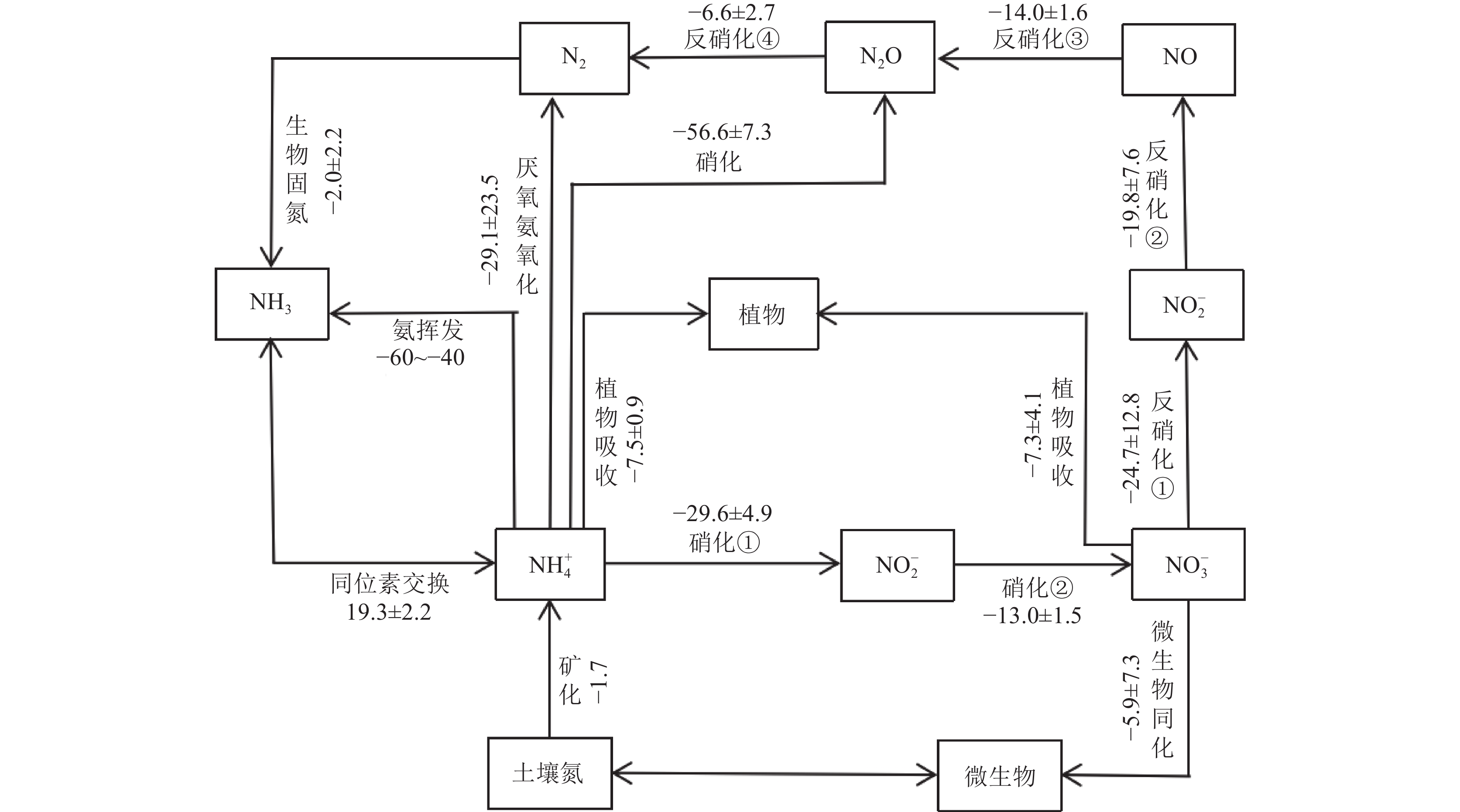
 下载:
下载:

